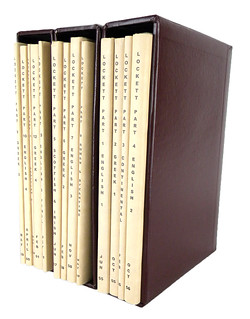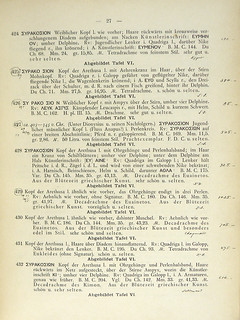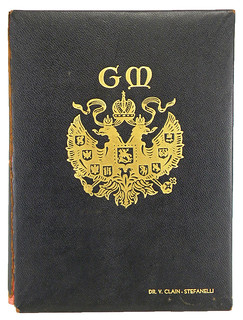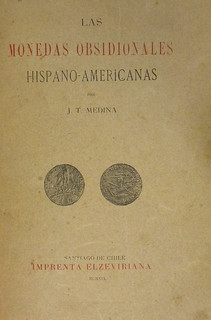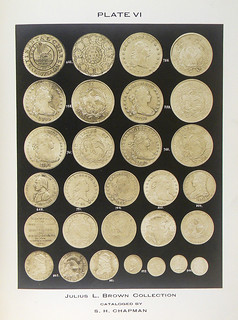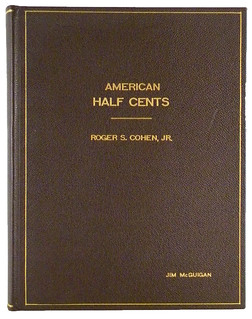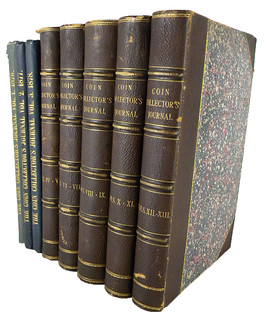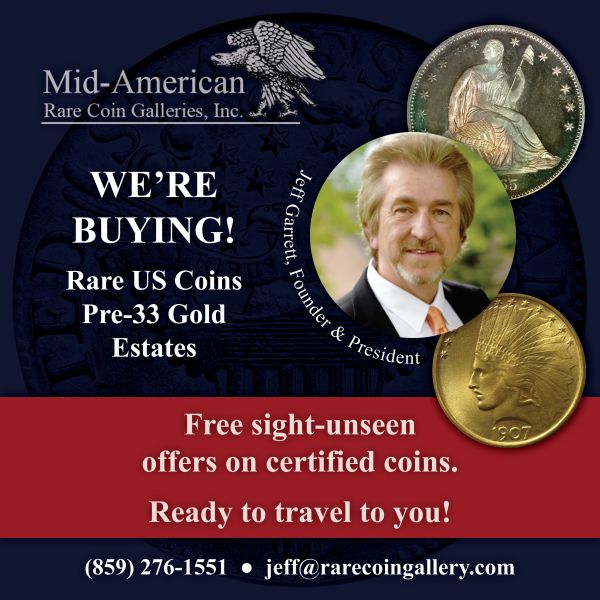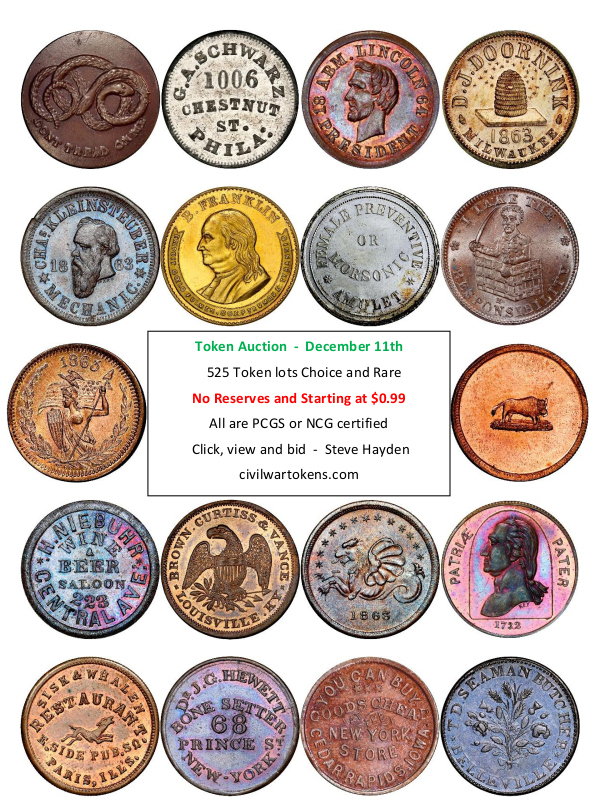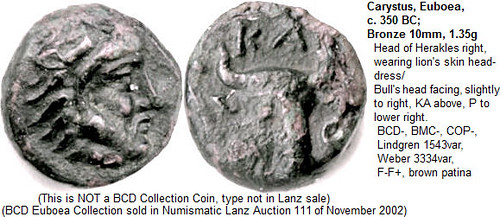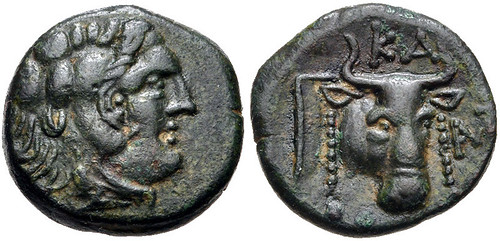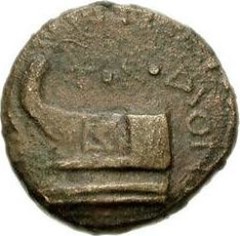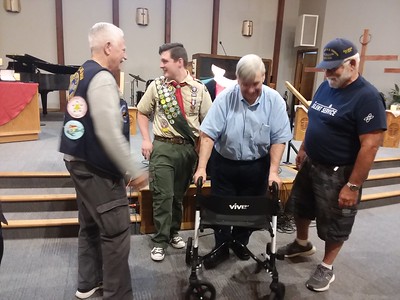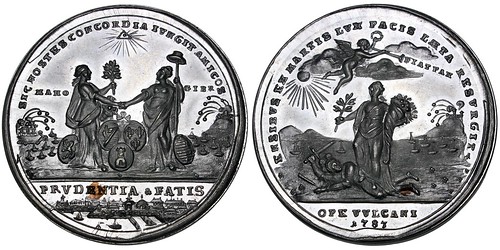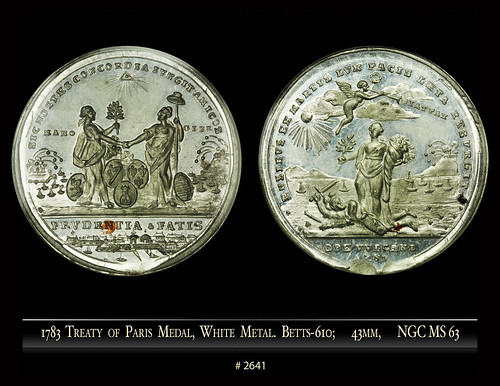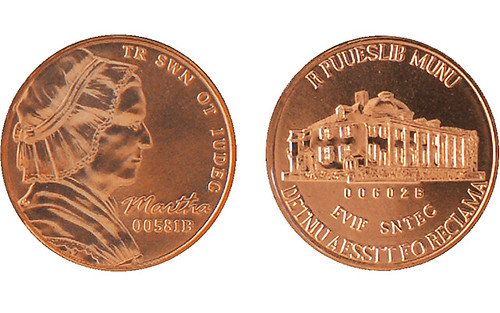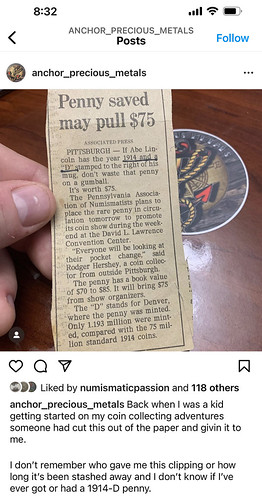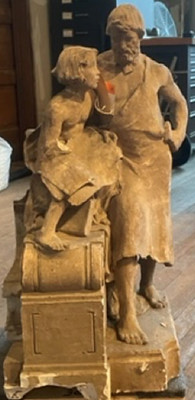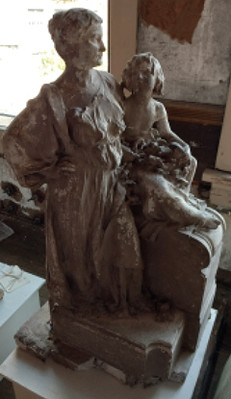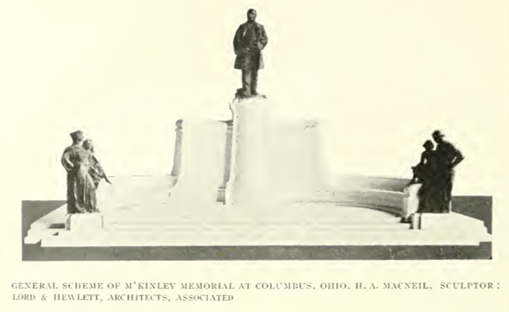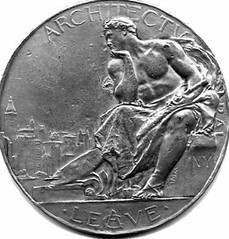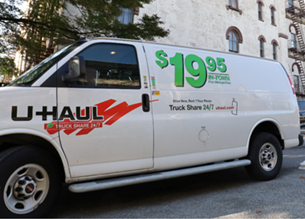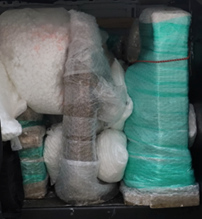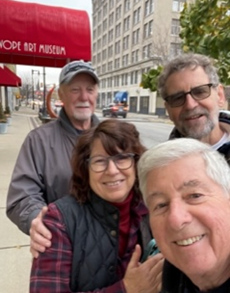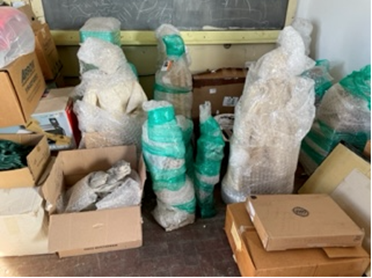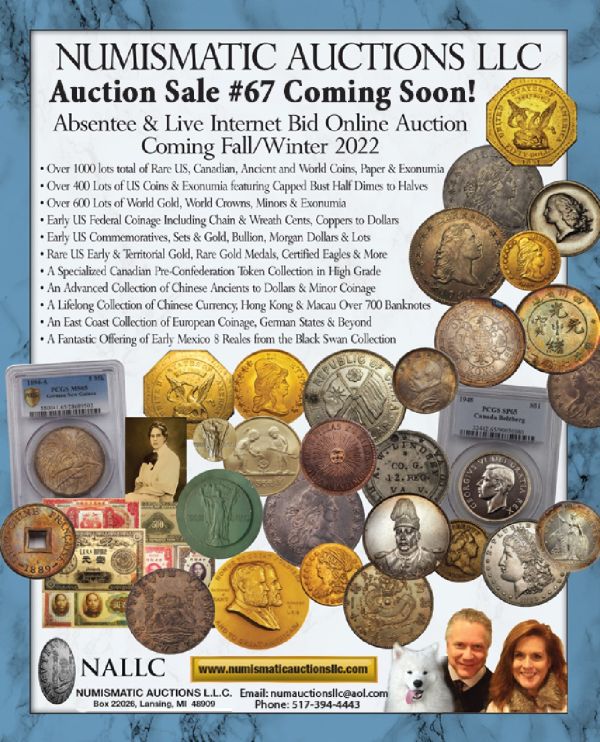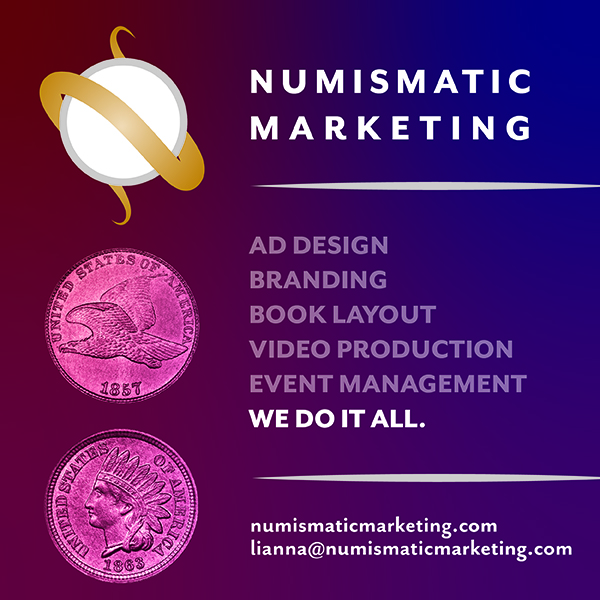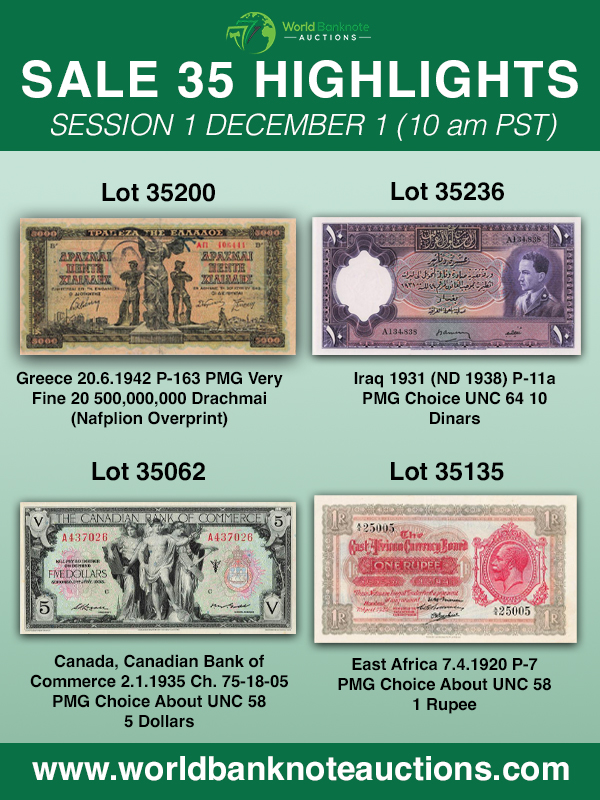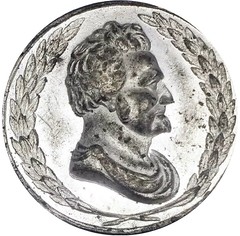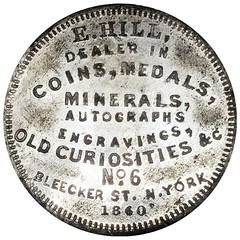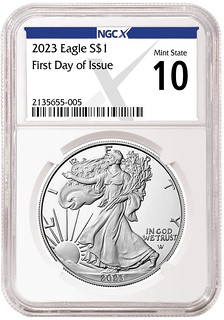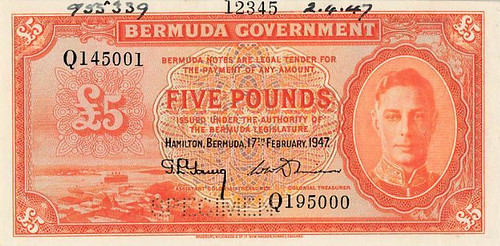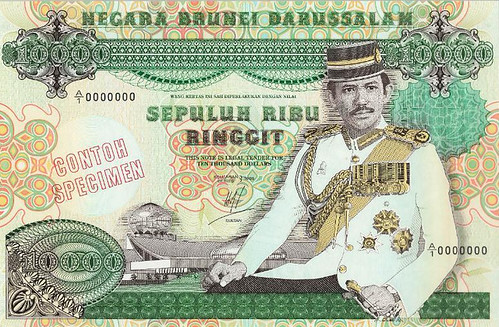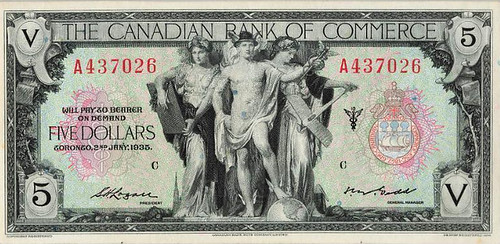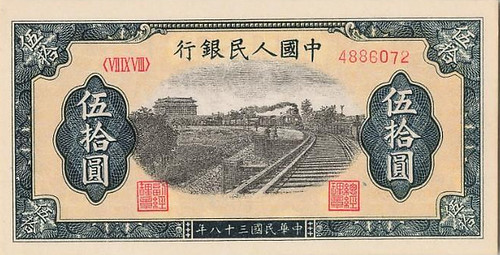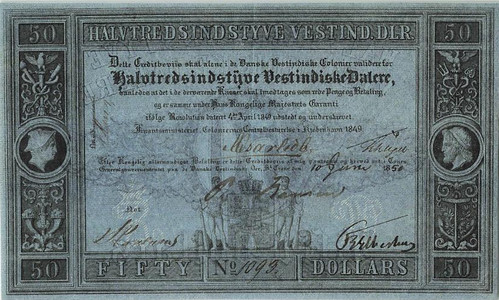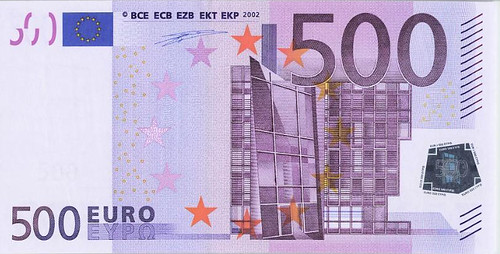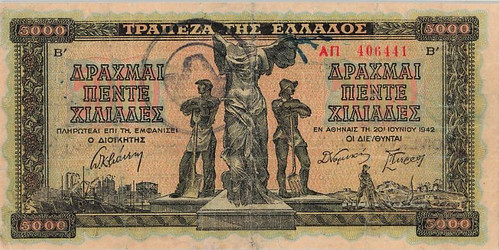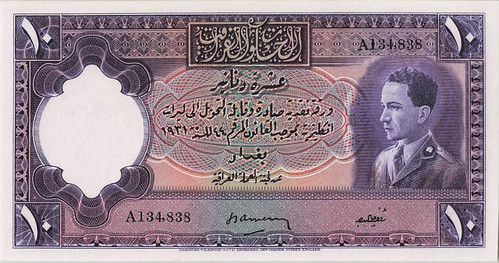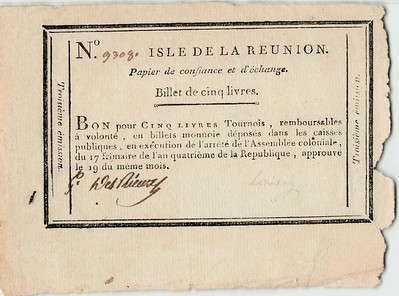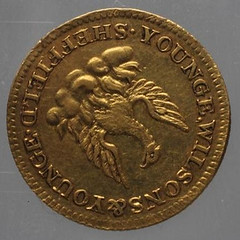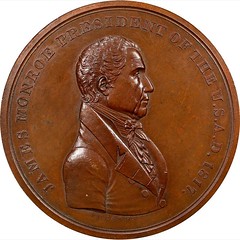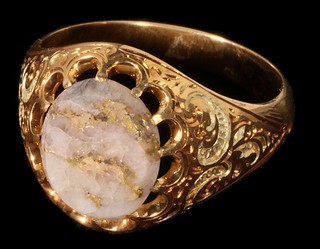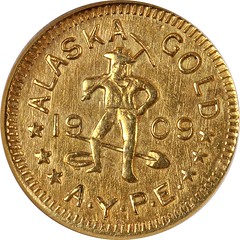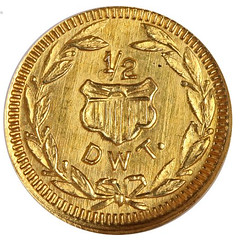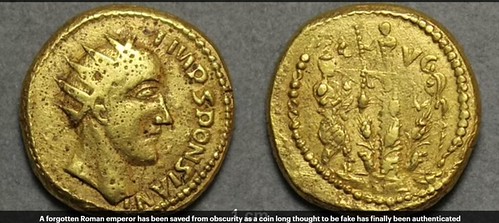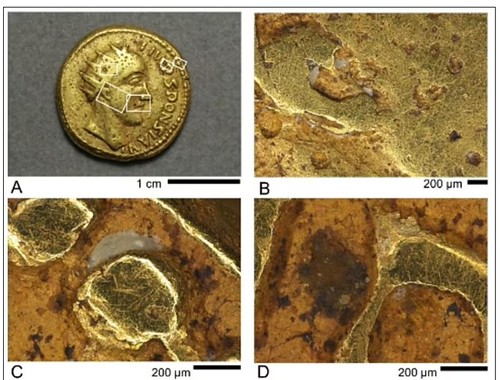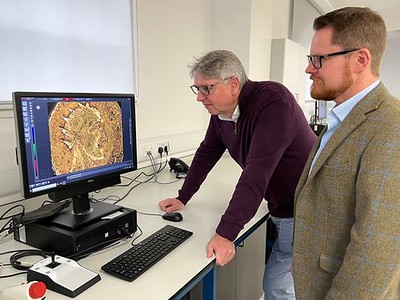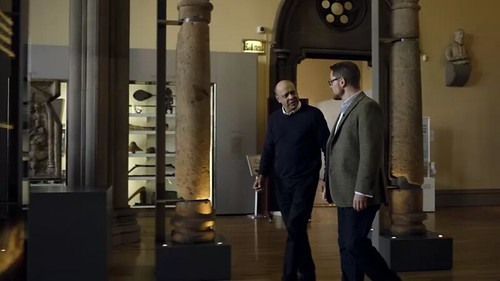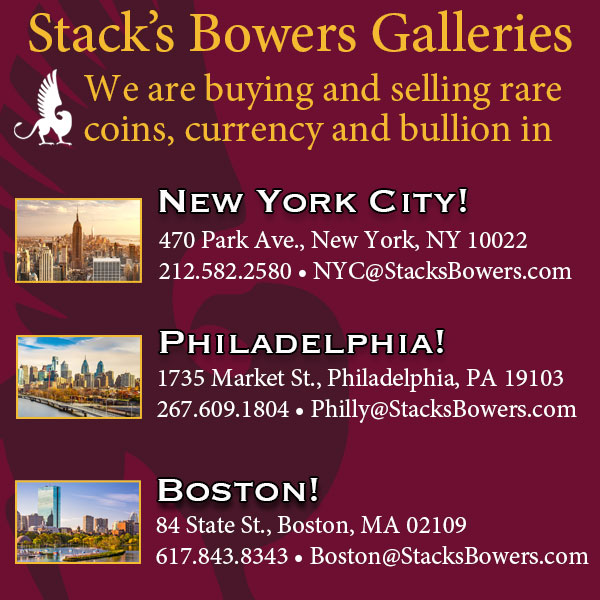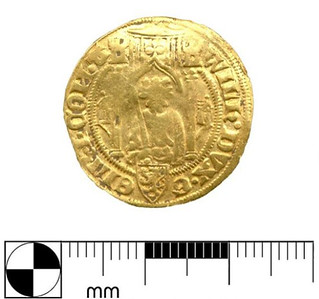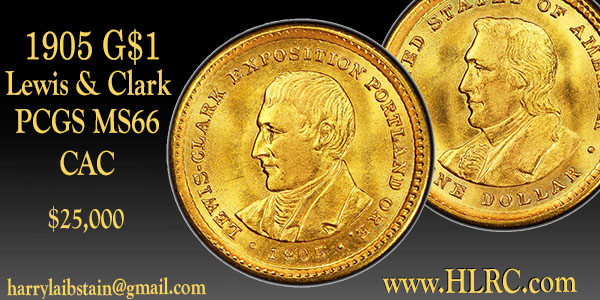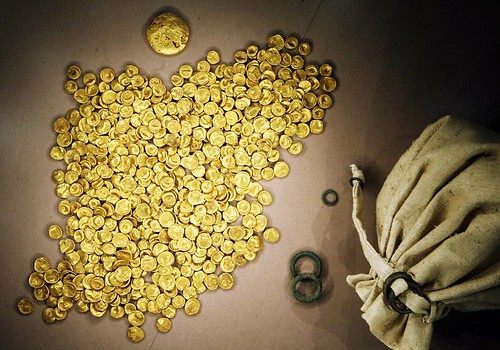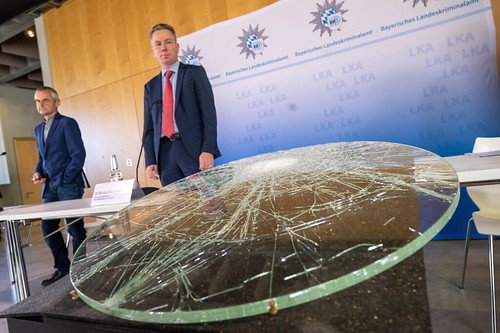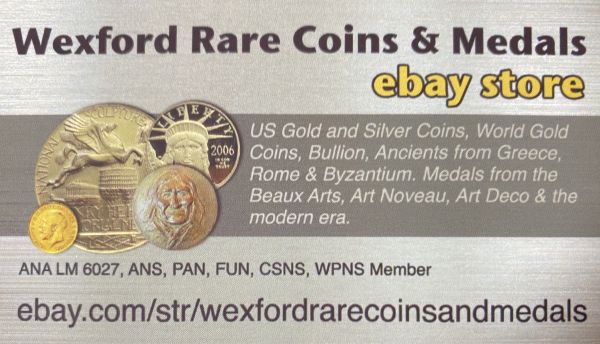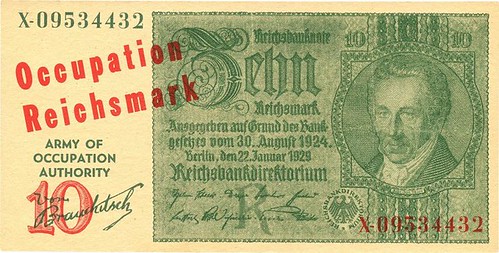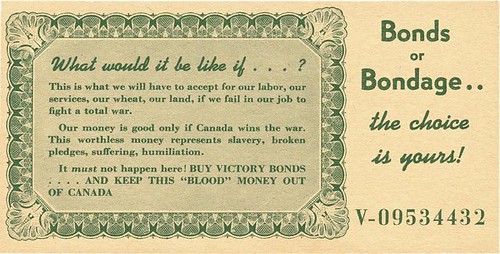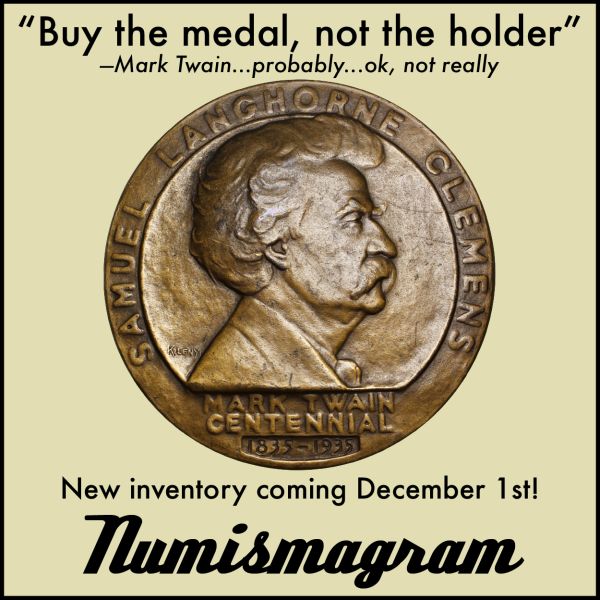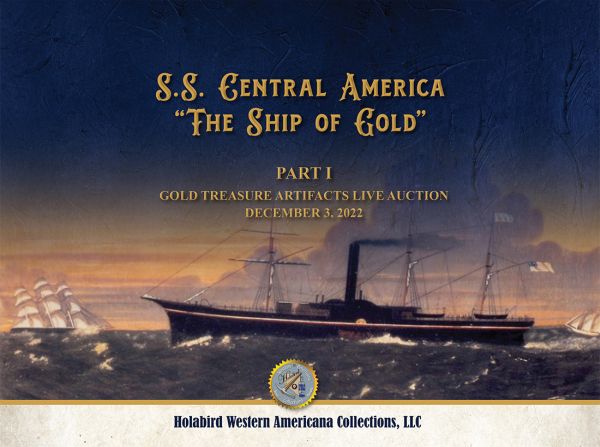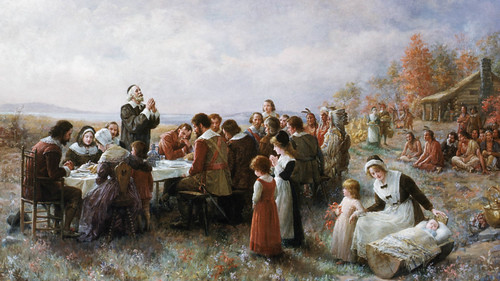
Visit our NBS Sponsors




About UsThe Numismatic Bibliomania Society is a non-profit association devoted to the study and enjoyment of numismatic literature. For more information please see our web site at coinbooks.org SubscriptionsThose wishing to become new E-Sylum subscribers (or wishing to Unsubscribe) can go to the following web page link MembershipThere is a membership application available on the web site Membership Application To join, print the application and return it with your check to the address printed on the application. Print/Digital membership is $40 to addresses in the U.S., and $60 elsewhere. A digital-only membership is available for $25. For those without web access, write to: Charles Heck, Treasurer AsylumFor Asylum mailing address changes and other membership questions, contact Chuck at this email address: treasurer@coinbooks.org SubmissionsTo submit items for publication in The E-Sylum, write to the Editor at this address: whomren@gmail.com BUY THE BOOK BEFORE THE COINSale Calendar |
- WAYNE'S WORDS: THE E-SYLUM NOVEMBER 27, 2022
- E-SYLUM SUBSCRIBER CONTEST REMINDER
- MORE KOLBE & FANNING SALE 165 HIGHLIGHTS
- NEW BOOK: THE EARLY BETTS MEDAL COMPANION
- NEW BOOK: INTERPRETING EARLY MEDIEVAL COINAGE
- NEW BOOK: SASANIAN COINS
- DOUGLAS EARL SPANGLER JR. (1946-2022)
- MORE ON THE CARNEGIE COLLECTION
- VIDEO: CHESTER KRAUSE
- MORE ON THE TREATY OF PARIS MEDAL
- RESPONSE TO THE "FRANKLIN CENT" ARTICLE
- NOTES FROM E-SYLUM READERS: NOVEMBER 27, 2022
- HERMON MACNEIL PLASTERS MOVE COMPLETED
- RIDDELL'S NOTES ON THE NEW ORLEANS MINT
- VOCABULARY TERM: MEDAL COLLECTING
- EZRA HILL (1838-1860)
- A PHOTOGRAPH OF JULES FONROBERT
- COUNTERFEIT TRAINING GIVEN TO LAW OFFICERS
- NGC INTRODUCES 10-POINT COIN GRADING SCALE
- WORLD BANKNOTE AUCTIONS SALE 35
- NUMISMATIC NUGGETS: NOVEMBER 27, 2022
- COIN OF SPONSIAN IS GENUINE. OR IS IT?
- MEDIEVAL COIN HOARD FOUND IN SCOTLAND
- CELTIC TREASURE COINS STOLEN IN GERMANY
- AUSTRALIAN VICTORIA CROSS AWARDS SOUGHT
- WINNIPEG 'IF DAY' PROPAGANDA NOTES
- NIGERIANS UNIMPRESSED WITH NEW BANKNOTES
- MAN PAYS LAWYER WITH ANCIENT COIN
- LOOSE CHANGE: NOVEMBER 27, 2022
- THANKSGIVING AND THE U.S. MINT
- FEATURED WEBSITE: HERMON A. MACNEIL
Click here to read the thin version on the web
Click here to subscribe
Click here to access the complete archive
To comment or submit articles, reply to whomren@gmail.com
Content presented in The E-Sylum is not necessarily researched or independently fact-checked, and views expressed do not necessarily represent those of the Numismatic Bibliomania Society.
WAYNE'S WORDS: THE E-SYLUM NOVEMBER 27, 2022
 New subscribers this week include:
Central Ohio Numismatic Association members
Steve Rayburn, Stanley J. Dobrowski and Gary Heberline, courtesy of CONA newsletter editor Gerry Tebben;
and Bill O'Brien.
Welcome aboard!
New subscribers this week include:
Central Ohio Numismatic Association members
Steve Rayburn, Stanley J. Dobrowski and Gary Heberline, courtesy of CONA newsletter editor Gerry Tebben;
and Bill O'Brien.
Welcome aboard!
I feel like Garrison Keillor who wrote, "Back in my [younger] days, I assumed I would die young and become immortal like Buddy Holly or James Dean, but I was too poor to afford a fast sports car or a chartered airplane, and soon I was too old to die young."
This week we open with our new subscriber contest, more highlights from the upcoming Kolbe & Fanning literature sale, three new books, updates from the Newman Numismatic Portal, and more.
Other topics this week include Chet Krause, Ezra Hill, Jules Fonrobert, the Treaty of Paris medal, the New Orleans Mint, medal collecting, counterfeits, another coin heist in Germany, and Nigeria's new banknotes.
To learn more about the Richard Cyril Lockett collection, Betts medals, dealer Doug Spangler, Wikipedia, the Young America Furnace Company, bookbinders, Hermon Atkins MacNeil's plasters, NGC's 10-point grading scale, the Dunscore medieval coin hoard, 'If Day" advertising notes, and the invention of national banks, read on. Have a great week, everyone!
Wayne Homren
Editor, The E-Sylum
E-SYLUM SUBSCRIBER CONTEST REMINDER
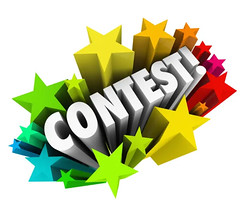 It was a slow week with the Thanksgiving holiday here in the U.S., but at least one subscriber started compiling email addresses and asked to donate his prize should he win. As a reminder, longtime reader and E-Sylum booster Martin Kaplan has donated $100 as a top prize for a new subscriber contest. I'll give 2nd and 3rd prizes of $50 and $25. Here's how it'll work:
It was a slow week with the Thanksgiving holiday here in the U.S., but at least one subscriber started compiling email addresses and asked to donate his prize should he win. As a reminder, longtime reader and E-Sylum booster Martin Kaplan has donated $100 as a top prize for a new subscriber contest. I'll give 2nd and 3rd prizes of $50 and $25. Here's how it'll work:
Send me ONE email at whomren@gmail.com with ALL the email addresses of people you think might like to become subscribers. List each address on a separate line. DEADLINE: DECEMBER 15, 2022. Put "E-SYLUM CONTEST" in the subject line and be sure to include your full name.
After the 15th I'll process the submissions in order of arrival, adding the new addresses and sending the newbies a note that it's a gift subscription on behalf of the entrant.
Only NEW subscribers count. If someone's address is already on our list they won't get added again. So no need to determine whether they already subscribe - there's no harm in having too many addresses.
Contest results will be announced in the DECEMBER 25, 2022 issue.
Remember, only send me ONE contest submission. And don't spam internet randos - these would ideally be people you know at least in passing, like fellow club members, customers, dealers you work with, or at just fellow numismatists likely to enjoy The E-Sylum. If you like, include with your entry a message to be sent with your gift subscription.
To read the earlier E-Sylum article, see:
NEW E-SYLUM SUBSCRIBER CONTEST!
(https://www.coinbooks.org/v25/esylum_v25n47a02.html)
MORE KOLBE & FANNING SALE 165 HIGHLIGHTS
Here are some additional highlights of the next Kolbe & Fanning numismatic literature sale. See an article elsewhere in this issue for more information on one of the lots. -Editor
 Kolbe & Fanning Numismatic Booksellers will be holding an auction sale this Saturday, December 3, 2022, beginning at 12:00 noon eastern time. The sale includes a wide variety of rare and out-of-print works on coins, medals, and paper money from antiquity to the present, and encompasses consignments from around the world. Some highlights of the sale include:
Kolbe & Fanning Numismatic Booksellers will be holding an auction sale this Saturday, December 3, 2022, beginning at 12:00 noon eastern time. The sale includes a wide variety of rare and out-of-print works on coins, medals, and paper money from antiquity to the present, and encompasses consignments from around the world. Some highlights of the sale include:
Lot 34: a complete priced and plated set of the thirteen Glendining's catalogues of the Richard Cyril Lockett collection
Lot 46: a priced and named copy of Jacob Hirsch's very scarce and highly important 1905 catalogue of the Rhousopoulos collection
Lot 106: the three-volume 1703 Amsterdam edition of Jean Foy Vaillant's Nummi antiqui familiarum romanarum, with 152 plates of coins
Lot 114: Bettange's rare 1760 TTraité des monnoyes, an important early work on the coining process, in contemporary bindings
Lot 159: Dr. Vladimir Clain-Stefanelli's copy of the rare deluxe edition of Abe Kosoff's Georgii Mikhailovich album, with additional photographs and letters
Lots 171: José Toribio Medina’s scarce 1919 publication on the obsidional coinage of Spanish America, one of only 150 copies printed
Lot 173: Admiral the Marquess of Milford Haven's classic 1919 folio on British naval medals, one of the true landmarks of numismatic literature
Lot 269: a fine plated copy of S.H. Chapman's 1911 catalogue of the Julius Brown collection, notable for ancient, British and American material
Lot 288: Jim McGuigan's copy of the rare leatherbound deluxe edition of Roger Cohen's 1982 American Half Cents: The Little Half Sisters
Lot 387: a complete set of J.W. Scott & Company's Coin Collector's Journal, among the most important 19th-century American numismatic publications.
Register early to bid online
Bids may be placed via post, email, fax or phone, as well as online. Kolbe & Fanning use Auction Mobility as our third-party online bidding platform. Auction Mobility is an app-based platform allowing users the ability to participate in the sale through phones, tablets and computers. To register for the sale, bidders must go to
bid.numislit.com and sign up. Once you have set up an account, you may browse lots, place advance bids, or participate in the live sale online. Those wishing to participate on their devices can download the Kolbe & Fanning app through the Apple or Google Play Store. The sale has also been listed on Biddr and NumisBids.
The printed catalogue has been mailed to all active customers on our mailing list. As international mail speeds have been inconsistent, we encourage our foreign clients to consult the electronic catalogue in case their printed catalogue does not arrive promptly. A PDF of the printed catalogue has been posted to our main website at numislit.com for those who prefer that format. Bids placed via post, email, fax or phone must be received by December 2, the day before the sale, in order for them to be processed. Advance absentee bids may also be placed at any time online at bid.numislit.com. Live internet bidding will be available during the sale itself through the same platform.
Kolbe & Fanning Numismatic Booksellers LLC is a licensed and bonded auction firm in the State of Ohio. For more information, please see the Kolbe & Fanning website at numislit.com or email David Fanning at df@numislit.com. To register for the sale, go to bid.numislit.com. We look forward to your participation.
To read the Catalogue PDF, see:
https://www.numislit.com/images/upload/kolbefanningsale165.pdf
To read the earlier E-Sylum articles, see:
KOLBE & FANNING AUCTION SALE 165 ANNOUNCED
(https://www.coinbooks.org/v25/esylum_v25n46a02.html)
KOLBE & FANNING AUCTION SALE 165 HIGHLIGHTS
(https://www.coinbooks.org/v25/esylum_v25n47a04.html)
NEW BOOK: THE EARLY BETTS MEDAL COMPANION
As noted a few weeks ago, Chris McDowell has written a new book on Betts medals, and it's now available from the ANS for preorder. Here's the announcement. -Editor
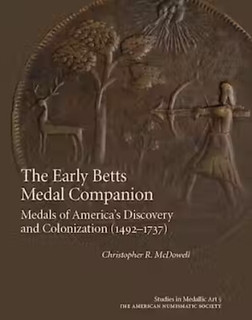 The American Numismatic Society (ANS) is pleased to announce the publication The Early Betts Medal Companion: Medals of America's Discovery and Colonization (1492–1737), the fifth volume in the Society's Studies in Medallic Art series.
The American Numismatic Society (ANS) is pleased to announce the publication The Early Betts Medal Companion: Medals of America's Discovery and Colonization (1492–1737), the fifth volume in the Society's Studies in Medallic Art series.
Authored by Christopher R. McDowell – ANS Fellow, editor of the Journal of Early American Numismatics, and President of the Colonial Coin Collectors Club (C4) – this book brings to fruition the dream of nineteenth-century numismatist Charles Wyllys Betts to illustrate American colonial history through contemporary medals. Focusing on medals from the period of discovery through the period of colonization of the New World, McDowell's volume is a companion to Betts's masterpiece, American Colonial History Illustrated by Contemporary Medals. This is the first of what is expected to be three volumes by McDowell concerning Betts medals.
Since Betts' text first appeared posthumously in 1894, new information has come to light regarding each medal he enumerated. The Early Betts Medal Companion updates and illustrates each listing in the first two chapters of Betts, known to collectors and researchers as Betts-1 to Betts-170. Although Betts stated that his work was an "illustrated" history, very few actual illustrations or drawings were included in the original. With only a few exceptions, every Betts medal discussed is illustrated here, many for the first time. In addition, the contextual history of each medal is told, explaining their design and importance. Finally, pricing information is included for every medal for which pricing is available.
The cost of the book is $125 plus shipping and handling, with members receiving 30% off. All members can apply the ANS 30 discount code during checkout for the member cost of $87.50. Pre-ordering is now open for The Early Betts Medal Companion, through the ANS distributor, Casemate Academic. Books will ship to customers in December.
Dr. Jesse Kraft, ANS Resolute Americana Assistant Curator of American Numismatics, praised the book. He noted,McDowell provides the most comprehensive resource on the subject of Betts medals. This book provides much-needed and up-to-date context to Betts' work, ranging from U.S., North American, and world history to the evolution of American numismatics and, of course, about the medals themselves. Perhaps most striking about the updated understanding of this material is that some of the medals in the Betts book never even existed. Without McDowell's meticulous research, future generations of numismatists would still be searching for them. For McDowell, this truly is a labor of love.
The Early Betts Medal Companion
Medals of America's Discovery and Colonization (1492–1737)
by Christopher McDowell
Series: Studies in Medallic Art
Imprint: American Numismatic Society
340 Pages, 8.5 x 11 in
Hardcover
For more information, or to order, see:
The Early Betts Medal Companion
(https://www.casemateacademic.com/9780897223898/the-early-betts-medal-companion/)
NEW BOOK: INTERPRETING EARLY MEDIEVAL COINAGE
The British Numismatic Society has published a festschrift for Stewart Lyon. -Editor
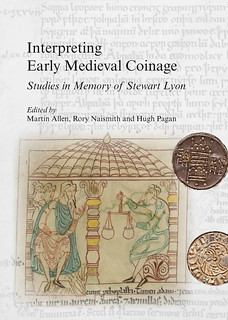 Interpreting Early Medieval Coinage. Essays in Memory of Stewart Lyon
Interpreting Early Medieval Coinage. Essays in Memory of Stewart Lyon
British Numismatic Society Special Publication No. 15
Edited by Martin Allen, Rory Naismith and Hugh Pagan
£45.00
Over a period of some sixty-five years, Stewart Lyon (1926–2021) brought an exceptional quality of intellect and a deep engagement to the study of Anglo-Saxon and related coinages. This volume represents a tribute to his achievement. It assembles the work of thirteen established and rising scholars of early medieval numismatics and allied disciplines. Their work includes up-to-date surveys, the results of detailed research and discussions of important new finds, all selected to complement the interests of Stewart himself. The coverage ranges widely chronologically and geographically, from the collapse of Roman Britain to the twelfth century, and from Whitby to Wales and Normandy. Taken as a whole, the essays in this book represent both a celebration of Stewart's memory, and an assemblage of scholarship of lasting significance for all those interested in the coinage of medieval Britain. The volume concludes with a bibliography of Stewart Lyon's publications.
Available from Spink with a 25% discount for BNS members: £33.75.
For more information, or to order, see:
Interpreting Early Medieval Coinage. Essays in Memory of Stewart Lyon, British Numismatic Society Special Publication No. 15, edited by Martin Allen, Rory Naismith and Hugh Pagan
(https://spinkbooks.com/products/interpreting-early-medieval-coinage-essays-in-memory-of-stewart-lyon-british-numismatic-society-special-publication-no-15-edited-by-martin-allen-rory-naismith-and-hugh-pagan)
NEW BOOK: SASANIAN COINS
Bagchee, a book store in New Delhi, India is offering a new book on Sasanian coins. It's a compendium of reprinted articles on the topic. -Editor
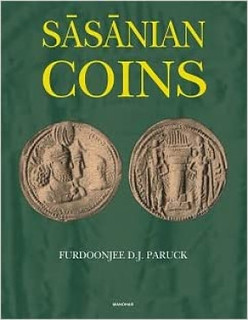 Sasanian Coins
Sasanian Coins
Furdoonjee D.J. Paruck (Author)
Information on Sasanian numismatics has been published in journals of various societies across Europe, especially in France, Germany and Russia, but is not available in the form of books. Sasanian numismatics has been under-represented in the English literature on coins. This has posed a serious challenge for those who have acquired Sasanian-era coins as well as those who seek them, as they do not have a source of reference to turn to for guidance and assistance. This is because despite the importance of this subject, no effort has been made to publish a comprehensive and collected account of Sasanid coinage, and the information that is available is largely scattered.
Format Hardcover
Date published: 01.01.2023
Edition: Reprint.
Publisher: Manohar Publishers & Distributors
Language: English
ISBN: 9789394262331
Length: 634p., Plates
For more information, or to order, see:
Sasanian Coins
(https://www.bagchee.com/books/BB137300/sasanian-coins)
DOUGLAS EARL SPANGLER JR. (1946-2022)
Mark Fox of Michigan submitted this remembrance of ancient coin dealer and collector Doug Spangler. Thank you. -Editor
A Big Deal in Small Coin Dealing:
Douglas Earl Spangler Jr. (1946–2022)
by Mark Fox
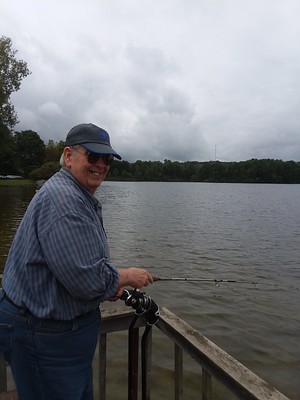 It is with a very sad heart that I announce the passing of Doug Spangler on the morning of November 22, after battling Alzheimer's for several years. He was seventy-five and born on December 27, 1946, in Cleveland, Ohio. Who is Doug, one might ask? With his wife Carol of fifty-three years in marriage (who ever so gently broke the news to me), they are, simply put, a pair of small-time ancient coin dealers whose contagious kindness and friendliness make this hobby worth enjoying and life worth living.
It is with a very sad heart that I announce the passing of Doug Spangler on the morning of November 22, after battling Alzheimer's for several years. He was seventy-five and born on December 27, 1946, in Cleveland, Ohio. Who is Doug, one might ask? With his wife Carol of fifty-three years in marriage (who ever so gently broke the news to me), they are, simply put, a pair of small-time ancient coin dealers whose contagious kindness and friendliness make this hobby worth enjoying and life worth living.
According to my records, my first coin purchase from them was on eBay, in March of 2014, and consisted of an ancient Greek bronze purportedly issued by Carystus on the island of Euboea. This city’s coinage was on my mind a lot back then (which involves a different story), so I was glad to finally snag a piece. Later on, however, I realized that it was actually an issue of Dicaea (Dikaia) in Thrace, a coin type that is confused notoriously often with its Carystian counterpart, right down to the positioning of two of the letters on the reverse! I told Doug about my discovery several months later, in December, and in spite of the long lapse in time, he wanted to take the coin back and make things right. I told him that I didn’t mind holding on to the pseudo-Carystus
specimen since it was still a rare coin and a type unrepresented in my collection. (Let’s be honest: when it comes to numismatics, I am not very fussy. If I buy a beaten up LRB for $5 and it was found to be misidentified, but worth a million dollars, I will probably still keep it, assuming inflation eases a bit.)
For interest, I have enclosed the original auction photo of the Dicaea coin (which demonstrates Doug's unique way of condensing all his research into a single JPEG image) paired with a real Carystus issue of the head of Heracles/bull's head bronze type (courtesy of CNG, LLC; E-302, lot 78; 17mm, 4.59 g, 12h).
Little wonder they are such coin attributing headaches! That said, the stark differences in diameter and weight are important hints that the two are not twins.
Through that single purchase, I quickly got to know the Spangler family and I would come back again and again for more numismatic goodies that were seemingly custom-tailored to my research projects and collecting appetite. Were they psychic? I also bombarded them regularly with research questions about this or that coin, helpful answers to which were always sent via the . S. Patience. Being located in my home state, I teased them once that they gave new meaning to the phrase buy local
!
Although the facts are usually uncovered gradually, they make it no less shocking to realize how many of my numismatic friends have humbly lived lives that stretched well beyond coins, into many equally amazing directions where they have done their part to help build the good side of the world that we live in today. In Doug’s case, it was his role as a submariner
and a nuclear power plant consultant engineer. When the city of Holland was brought up one time during one of our many e-mail exchanges, he waxed nostalgic:
When you mentioned Holland, MI, I was filled with memories of working on Michigan’s west coast! I worked at Nuclear & some coal-fired power plants from D.C. Cook Nuke plant south of Stevensville-Benton Harbor to plants near Muskegon, Holland, Grand Haven, all the way up to Big Rock Point near Charlevoix. I would work weekdays and come home most of the weekends, except a few when Carol would come with me for things like the tulip festival at Holland. It definitely is a very nice area and somewhat more temperate than the middle of the state.
I was a nuclear instrument technician in the U.S. Navy Submarine fleet during the Vietnam era, 1967-1974, and continued it in the private sector until retiring a few years ago [in 2011]. I went into the coin business in 1976 and have enjoyed it—and even more after retirement. Now Carol and I keep the ten-acre homestead going and watch the grandkids grow! It is easy as they live on an adjoining 5-acre parcel.
What wasn’t particularly easy, though, by Carol’s own testimony, was selling coins (and some antiquities) before the advent of the Internet, back in the ‘ol printed pricelist days:
Somewhere in our cupboards we have a bunch of our old lists. Yes, there were lots of photos, taken on film and developed. Then they had to be gone through, picked out, individually cut out, mounted on large poster board sheets. Before taking them to the printers, we used Amberlith—an orange see-through covering, and then we used an Exacto knife to cut around the images—it was an interesting and time-consuming job. Then they had to be taken to the printers. Then they had to be collated, folded, labeled, and stamped. Our son & daughter remember helping with that.
That little window into the archaic past was recounted in November 2016. A bit earlier, they had kindly gifted me with one of their vintage mail-order catalogs (from 1980 if I recall correctly), thus temporarily holding back my souvenir obsession. Though handsomely simple, with a lot of juicy B&W images for the provenance hunters among us, it is still strange to think how such a booklet, shortly after its laborious printing, was probably seen as little better than junk mail
in the eyes of most contemporary collectors. How times have changed!
For the Spanglers, they would change significantly in or around 1999 when they decided to set up shop on eBay. The change in venue, however, apparently did little if anything to dampen Doug’s careful scholarship (minus the occasional slip-up that even the largest auction houses are not immune to). From his auction descriptions, one could tell he was being guided in his attributions by a solid, personal library of paper and ink and not some other online seller’s cloned reiterations of questionable accuracy. One of my many research projects that sent him to mull over his stock and sale records concerned this mysterious Roman provincial issue of Vespasian:
The result of his meticulous search, however, was an apology for returning empty-handed and this clever quote: "I gave it the old college try, but then again, I did nothing worthwhile in college except meeting the love of my life, Carol. I'm eternally grateful for that."
If it wasn't already obvious from the first photo of Doug, he also had a soft spot for fishing, a sport that he continued to enjoy in his later years, even after the effects of his dementia had weakened his participation in the coin hobby.
In regards to Doug's service, his family did not want it to be forgotten. As Carol related to me in August 2018, not too long after a family trip to Minnesota:
Our daughter, Leah, had arranged to have Collin’s [Doug and Carol’s grandson’s] high school graduation reception after his Eagle Court of Honor ceremony. She contacted a submarine group in Minnesota. When asked, various organizations will send out a letter of commendation regarding making Eagle Scout. When the submarine group found out that Grandpa (Doug) had served on a sub, the fellow asked if he could come and present the letter to Collin (they usually send it in the mail). Two former submariners came. One fellow did an introduction, the other fellow read the letter of commendation and then he had Doug present the letter to Collin. Then the submariners thanked Doug for his service and gave him a commemorative Submarine coin. It was quite nice and the best part of the ceremony, at least I think so.
Carol has informed this writer that she is planning to add some more content/finishing touches to a proper biography of Doug that they had previously collaborated on, the finished product of which she will likely share with me eventually—and me possibly with the wider numismatic world (pending her permission). For the time being, readers can find a well-rounded summary of Doug’s life, in contrast to my lop-sided view, on Legacy.com, published by Eagle-Marry Funeral Home:
https://www.legacy.com/us/obituaries/name/douglas-spangler-obituary?id=38213904
A funeral Mass was held for Doug on Saturday, November 26, 2022, at St. Mary on the Lake Catholic Church in Manitou Beach, Michigan, followed by his burial at Calvary Cemetery in Hudson. Two coins had been placed in Doug’s pocket: one of Caesar (recalling Jesus’ quote: Render unto Caesar the things which are Caesar’s, and unto God the things which are God’s
) and a widow’s mite.
Now, normally, this would be a good place to end most obituary-themed works, but I think this remembrance of Carol's makes for a much better closing:
"This was like 10 years ago and one of my fondest memories–
 Doug loved God, family, and country. He was a great husband, a wonderful father, and a loving grandfather. The grandchildren have fond memories of Grandpa at his desk, ˜working on coins.' He would put a grandchild on his lap, tell them about the coin he was working on and often surprised them with a coin and attribution just for them. Doug enjoyed listening to Grandma and the grandchildren laughing, playing games, or baking cookies. There were times with six grandchildren in the house ranging in age from 4 to 12, where the noise volume would increase tremendously.
Doug loved God, family, and country. He was a great husband, a wonderful father, and a loving grandfather. The grandchildren have fond memories of Grandpa at his desk, ˜working on coins.' He would put a grandchild on his lap, tell them about the coin he was working on and often surprised them with a coin and attribution just for them. Doug enjoyed listening to Grandma and the grandchildren laughing, playing games, or baking cookies. There were times with six grandchildren in the house ranging in age from 4 to 12, where the noise volume would increase tremendously.
With a knowing smile, Grandma would ask them to quiet down or ‘Grandpa will start growling,’ and on cue and much to the delight of the grandchildren, Grandpa would lovingly start to growl.
To read his online obituary, see:
Douglas Earl Spangler Jr.
(https://www.legacy.com/us/obituaries/name/douglas-spangler-obituary?id=38213904)
MORE ON THE CARNEGIE COLLECTION
Newman Numismatic Portal Project Coordinator Len Augsburger provided the following report in the 1980s Carnegie Museum sales. Thanks. -Editor
More on the Carnegie Collection
Last week Alan Weinberg noted the sale of portions of the Carnegie Museum of Natural History collection. Spink & Son USA sold a number of deaccessioned items on September 14, 1982, which consisted of United States silver dollars from the Carnegie collection (lots 331-429). Highlights include a set of proof Trade dollars from 1873-1883, and a run of Morgan dollar proofs from 1878-1904, including many duplicates as well as the rare 1895 issue (realized $9,500), which served as the catalog cover plate coin. The 1921 Zerbe proof is also present. Highlights from earlier pieces include a 1794 dollar in VG/F (realized $12,500), an 1836 Gobrecht dollar, an 1865 Seated dollar with motto (Judd-434, realized $4,500) and a Mint State 1872-CC example (realized $3,750).
The Coin World auction calendar published November 16, 1983 notes a November 10-11 sale of ancient & U.S. coinage and paper money from the Carnegie Museum of Natural History.
However, the Spink & Son USA catalog for that date gives no indication that Carnegie Museum was the consignor. In addition, no paper money is present. Coin World further reports on August 29, 1984, the upcoming sale of medieval coins from Carnegie in the October 10, 1984 Spink & Son sale. While this doesn't trace Weinberg's high-grade example of the 1793 S-3 large cent, it's clear that Carnegie was actively deaccessioning its numismatic collection.
To read the earlier E-Sylum articles, see:
THE CARNEGIE MUSEUM COIN SALES
(https://www.coinbooks.org/v25/esylum_v25n47a11.html)
NOTES FROM E-SYLUM READERS: NOVEMBER 20, 2022 :
Notes from Alan V Weinberg
(https://www.coinbooks.org/v25/esylum_v25n47a12.html)
VIDEO: CHESTER KRAUSE
The David Lisot Video Library on the Newman Numismatic Portal can be found at:
https://nnp.wustl.edu/library/multimediadetail/522852
We highlight one of his videos each week in The E-Sylum. Here's one from 1986 with Krause Publications founder Chet Krause. Numismatic history, directly from the man who made it. -Editor
ANA Numismatic Personality: Chester Krause David Lisot, Interviewer.
It's interesting to hear his perspective on the development and growth of baseball card collecting as a counterpoint to the (at the time) more advanced world of numismatics. -Editor
To watch the complete video, see:
https://nnp.wustl.edu/library/book/557345
THE BOOK BAZARRE
MORE ON THE TREATY OF PARIS MEDAL
Peter Jones submitted these thoughts on the Treaty of Paris medal. Thank you! -Editor
I read with interest Jeremy Bostwick's listing of the Betts 610 Treaty of Paris/Peace of Versailles medal in white metal in The E-Sylum. The medal is interesting for a number of reasons.
Most copies I see show the copper plug carefully placed below the exergual line on the obverse, and my medal (illustrated) shows it in almost exactly the same position.
Most copies of the medal I have seen on the internet are remarkably free from the usual ugly toning seen on white metal medals, presumably from the scavenger plug. The copper plug attracts corrosion, protecting the white metal, in a similar fashion to Intercept Shield& storage products which use a patented sacrificial corrosion agent.
MAHO refers to the Battle of Port Mahon on the eastern end of Minorca, which started the Seven Year's War in Europe in 1756. The battle was between the British and French. The British sent Admiral John Byng with 10 ships of the line to defend the British garrison in Minorca. But he was too timid, suffered unnecessary damage, and retreated. The next year, the British Admiralty court-martialed him and executed him for failing to fulfill orders.
The GIBR on the obverse right and the similar scene on the reverse right show the British held Gibraltar defending itself firing cannon onto the French and Spanish fleets during the Great Siege of Gibraltar 1779-1783. The besiegers lost over 6,000 killed or wounded. The British garrison lost only 1,341. But the British tied up Spanish and French forces for several years. The British negotiated the Treaty of Paris during the siege.
Forrer's Biographical Dictionary of Medallists lists Johan Christian Reich as engraving "Peace of Versailles". John Kraljevich also says the engraver was J. C. Reich (ca. 1740-1814), the father of the Philadelphia Mint engraver John Reich, whose German name was Johan Matthias Reich. Their family were jeton engravers. Enormous numbers of counting tokens were manufactured in Nurnberg (now Germany). However, the Reich family decided to compete. Nurnberg objected, so around 1758, the Reichs moved manufacturing to Furth, 100 miles away. They became very successful. One of his sons was John Reich (1768-1833). John emigrated to the U.S. in 1800. Some of his work caught the eye of Thomas Jefferson who appointed him to the mint in 1801. But the Mint would only give him menial tasks, so he almost left to return to Furth. But in 1807, he was appointed assistant US Mint Engraver under Chief Engraver Robert Scott until 1817, when he retired.
Some questions:
Why does America have a Dutch style, not an American style liberty cap?
There are only 9 stripes to the American shield (and is there a numeral 9 at the bottom of the shield?). Was this artistic license? Or was the engraver saying he knew that only nine states originally voted in favor of the Declaration of Independence in the initial vote on July 1, 1776? Or did it mean something else?
To read the earlier E-Sylum article, see:
NUMISMAGRAM SELECTIONS: NOVEMBER 20, 2022
(https://www.coinbooks.org/v25/esylum_v25n47a17.html)
RESPONSE TO THE "FRANKLIN CENT" ARTICLE
Craig Sholley submitted these comments in reaction to the piece last week on the Fugio Cent. -Editor
Craig Sholley
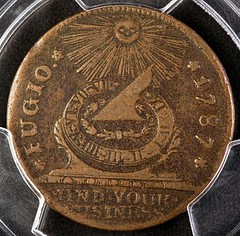 I read the most interesting article on Benjamin Franklin designing the Fugio (or Franklin) cent in
the November 20th issue of The E-Sylum. In fact, I found it so captivating that I had to click on
the link and read the full article. What a charming tale. I have just one small issue with the
story – it's simply not true.
I read the most interesting article on Benjamin Franklin designing the Fugio (or Franklin) cent in
the November 20th issue of The E-Sylum. In fact, I found it so captivating that I had to click on
the link and read the full article. What a charming tale. I have just one small issue with the
story – it's simply not true.
Aside from designing the thirteen interlocking rings motif which was copied from Continental currency and modified for use on a coin, Franklin had no connection whatsoever to the Fugio cent. He most certainly did not design it and he most certainly had nothing to do with establishing the weight standard.
How did this myth spring up? The term Franklin Cent
dates to at least the mid-19 th century, and likely much earlier. It was in common use by 1859 as John K. Curtis’ fixed price list of that year offered Franklin Cents
for sale at 25 cents to $1.50. The term was also used in auction catalogs by W. Elliot Woodward, Edward Cogan, and others from 1860 on. Since dealers and auctioneers were using it, the term had obviously been in common use for some time.
How did the term originate? According to an 1860 report on the numismatic holdings of the American Antiquarian Society, the term arose from a belief that the motto
Mind Your Business
was penned by Franklin. No proof of Franklin creating the motto is offered, nor can I find any.
The attribution of Mind Your Business, Fugio, and the sun and sundial, to Benjamin Franklin
apparently came about from a bit of guilt by association.
As Eric Newman noted in his
Continental Currency
those features had appeared on Continental Currency, along with a
design that Franklin did create – the thirteen interlocking rings with the words American
Congress
and We Are One.
Since Franklin was known to have created the rings design,
it
seems that people simply assumed he was responsible for the rest, and the myth was thus
born.
As to the weight of the Fugio cent, it was Congress that established the weight, passing a law on August 8, 1786 that established the denominations of and weight standards for United States coinage. For the cent, the act specifically states, "That the two copper coins shall be as follows: one equal to the one hundredth part of a federal dollar, to be called A Cent; And one equal to the two hundredth part of a federal dollar, to be called A Half Cent. That two pound and a quarter avoirdupois weight of copper, shall constitute 100 cents. There is no mention of Franklin in the legislation or associated records. In fact, he wasn't even in Congress at the time; he was the governor of Pennsylvania.
So, how did we get from a coin being nicknamed because it copied a saying thought to have been created by Benjamin Franklin to Franklin having not only designed the coin, but also setting the weight standard? For that we have only to thank the greatest echo chamber rumor mill ever created – the internet.
In 2013, the Fugio Cent Wikipedia page was edited by an anonymous user using the IP 216.106.225.171. Previously the page stated that the Fugio Cent was thought to have been designed by Benjamin Franklin. The anonymous editor altered that to state that the cent was designed by Franklin. Who knows why. Maybe he (or she) truly believed that. Maybe it was part of a coin promotion. Maybe they did it just to troll.
Whatever the reason, internet rumor mongers quickly spread the word to the point that today there are dozens upon dozens of posts, each repeating the other in standard internet fashion, claiming that Franklin designed the coin. Of course, no supporting evidence is offered. "Evidence" is a dirty word on the internet. It is only necessary to be on the most popular side of whatever meme or trope is being spread.
So, who designed
the Fugio Cent? If one means, who created the various mottos and
features,
other than the reverse design, we really don't know. It seems most likely that the
principles involved, those being James Jarvis, Abel Buell, perhaps along with members of the
Congressional coinage sub-committee and/or Board of Treasury, chose to copy the devices
from Continental Currency since they were publicly familiar.
However, if we mean, who laid out the design such that the dies could be hubbed and it
reproduced well in striking,
we can positively state that Abel Buell designed
the Fugio Cent.
Of everyone involved, Buell knew what would work for engraving, hubbing, and striking from his
experience in creating the dies for the Connecticut halfpence. He understood the relief and
layout necessary to properly reproduce dies and to strike reasonably attractive coins. Thus, the
credit should go to him.
I'll close with my favorite Abraham Lincoln quote, Don't believe everything you read on the
internet.
Y eah, I read that on the internet.
Perfect - thank you! As a numismatic literature collector I've seen many of the older references to the "Franklin Cent," and was hoping someone would pick up on that.
Those of you who attended last week's NNP Symposium panel session "Your Club Publication: Creating and Sustaining Relevance" heard me note that our readers are a prime source of content, and if something is of interest to one reader, it's likely of interest to others as well. But that doesn't mean the reader or I have reviewed or vetted what the third party produced. While I have an extensive U.S. numismatic library at my fingertips, I wouldn't have the time to do that even for the topics that personally interest me. Luckily we're blessed with readers who are not only versed in, but are experts in multiple areas of numismatics. So not much gets past them. A subsequent issue often contains comments or even detailed responses like Craig's.
One must always consider the source. The "Ben Franklin's Fugio Cent" article came from the Foundation for Economic Education, which describes itself as a "newsletter for free-market news and analysis." The Fugio Cent was just a jumping-off point for the writer and most of the article (which I didn't excerpt) discussed Franklin's proposed thirteen virtues for personal development.
Of all the internet platforms (lookin' at you, Twitter and Facebook) Wikipedia is among the best at editing and moderation. There are real editors and enforced standards for citing resources. But without editors versed in numismatics, the question can become one of the sources the authors choose to cite. I'm happy to see references to the Red Book, American Journal of Numismatics, the University of Notre Dame Coin and Currency Collections, and most importantly, this year's announcement of PCGS's reclassification of the Fugio Cent as a regular-issue U.S. coin. But other citations include hobby newspaper articles and blog articles from commercial dealer websites, all of which can be guilty of copying mistakes published elsewhere, a common practice which predated the internet by thousands of years. Notably, the "was designed by Benjamin Franklin" line is not sourced.
Here's a general question - how many times must one walk past a pile of rubbish before one becomes complicit in it being there? Just because you didn't put it there shouldn't stop you from cleaning it up. While Wikipedia could have ended up as just another passing internet fad, it's gained staying power and influence, as the major search engines boost its ranking and feature its content. Here's what we published in The E-Sylum way back in October 2005:
"Our Featured Web Site last week was a section of the Wikipedia, an "open source" web-based encyclopedia project. I noted that "It is a very useful site, as long as one remembers that it is maintained by volunteers and should not be relied upon as the final word on any research topic."
Arthur Shippee writes: "Yes, it's maintained by volunteers --such as yourselves. Actually, you folks might want to think about making the Wikipedia a great numismatic site, by editing the existing articles & adding new ones. That's the theory behind the Wiki open-source idea. It's a very interesting notion, and depends on the general good will of the mass of users."
And here's an exchange from 2017:
Ron Haller-Williams writes: "... "If you see something that's wrong in Wikipedia, CORRECT IT !!!" If you have the knowledge, then Wikipedia depends upon YOU. Until I made a change, it even had my wife's grandfather living over 20 years longer than he actually did. And I've probably made over 80 other changes, many relating to numismatic aspects."
"See something, say something" is good advice. And if more numismatists would get involved, many improvements could be made. -Editor
Are any other readers Wikipedia editors today? Would anyone like to become one? Let us know and The E-Sylum can be a platform for finding and correcting major errors in numismatic topics.
I reached out to reader and contributor Gary Greenbaum for comment. Here's his response. -Editor
Gary writes:
"Thanks for drawing my attention to the Fugio cent article.
"As you're aware, I'm active on Wikipedia, especially in the numismatic area. I've never looked at this article and was interested to read Craig Sholley's piece.
"Craig's interesting and well-written piece traces the statement in the Wikipedia article that Franklin designed the coins to an anonymous editor in 2013 and he continues along that line, suggesting from that acorn an internet myth grew. So when I got your letter, I went to the online searchable The Numismatist and searched Franklin Fugio
.
"There's quite a lot, some of it more nuanced than others. Mitch Sanders in his November 2009 article (at page 43) that "Franklin's designs also were used for the first official U.S. coin, the 1787 Fugio cent (the same designs appeared on paper money in 1776). Similarly, John J. Kraljevich Jr. (Freedom of Expression, April 2008, pp. 73-76) states that the Fugio cent is based on Franklin's designs and colorfully adds, "When the Congress decided to issue a copper coin in 1787, the body agreed in short order to use Franklin's cartoonthis in an era when Congress moved even slower than it does today." Other articles paint Franklin's connections with varying degrees of certitude. Even Edward C. Rochette, for whom the ANA's Money Museum is named, stated (Franklin was right: time flies
, April 1994, pp. 543–544), Now I understand why Benjamin Franklin wanted a sundial and the word "fugio" placed on the first coins issued by the authority of the United States government."
"I found most interesting the report in the January 1958 issue of a reward offered by E.J. Theisen for proof as to the authorship of the Fugio cent. The result: "The offer of $250.00 for information as to the author of the design on the Fugio cent and his own interpretation thereof, which closed Oct. 24, 1957 did not elicit documentary evidence of this nature. There were only six entries, evidencing a lack of interest and acceptance of the current belief as to the author and the interpretation of the design. All entries inclined to the author being Benjamin Franklin, and much research to this end was made by Mrs. Marianne F. Miller of Albuquerque, N. M. which, however, failed to meet the requirements of the offer. Theisen seemed inclined to believe that the designer was Francis Hopkinson, and hoped that future research would back that claim, but apparently that never came to pass. (Reward fails to uncover author of Fugio cent
, p. 22)
"I've changed the article (as Craig, or anyone else, could do) to say that by some accounts
Franklin designed it; that seems to be where it should rest. If the numismatic world, and the journal of the ANA cannot dismiss Franklin's authorship as a myth, don't expect Wikipedia to. Wikipedia is a tertiary source, meaning it relies on secondary sources such as journal articles for its information, and the ANA's journal, what we Wikipedians would call a reliable source
, can't decide on the level of Franklin's involvement. Personally, I have no idea if he was involved. But this isn't an instance where vandalism to Wikipedia started an internet myth."
Craig adds:
"I probably should do some Wikipedia editing. The problem I have is I'd end up spending a majority of my time editing the problems I see in various numismatic and related pages instead of researching and writing articles.
"Hopefully, E-Sylum can energize some readers to become data reviewers and editors. If so, I'd be happy to email them a file of all of my past articles as reference material. Most of them are extensively footnoted with sources."
"I was aware of the numismatic references to Franklin supposedly designing all of the devices. However, I will point out that in reviewing the internet postings on the subject starting in 2013, I did not see any reference to any numismatic source.
"I did see a few posts referring to Wikipedia, the first one being in August 2013 on Now I Know (https://nowiknow.com/a-penny-earned/). Since that post is about 2 months after the Wikipedia edit, I concluded the edit was the original source. The rest of the posts I found simply echo-chambered each other.
"That is not surprising. I find that most general internet posts do not reference professional publications. Rather, they simply repeat something found somewhere else on-line."
I confirmed that the Wikipedia article has been changed. Thanks, all! -Editor
To read the Wikipedia entry, see:
Fugio cent
(https://en.wikipedia.org/wiki/Fugio_cent)
To read the earlier E-Sylum articles, see:
THE WIKIPEDIA AND NUMISMATICS
(https://www.coinbooks.org/esylum_v08n44a28.html)
THE MAKING OF A WIKIPEDIA ARTICLE
(https://www.coinbooks.org/v20/esylum_v20n33a13.html)
READER NOTES ON WIKIPEDIA
(https://www.coinbooks.org/v20/esylum_v20n34a16.html)
BEN FRANKLIN'S FUGIO CENT
(https://www.coinbooks.org/v25/esylum_v25n47a23.html)
NNP SYMPOSIUM 5 CONCLUDES
(https://www.coinbooks.org/v25/esylum_v25n47a09.html)
NOTES FROM E-SYLUM READERS: NOVEMBER 27, 2022
Young America Furnace Company Note Signer
In 2017 we discussed a group of three rare obsolete notes from the Young America Furnace Company of Petrea, Ohio. Dave Schenkman had provided the images. The firm was in business circa 1856-1860. -Editor
"The signature on the notes is that of my great great grandfather, James H C Miller. I was just digging up info on the furnace and happened upon your site. Thank you for posting the images. After decades of living in New York State, I find myself wandering the hills of southeastern Ohio where I grew up, digging into family history."
Thanks for letting us know! It's great to hear we've been able to connect someone with their family history. This is why we post articles online - one never knows where or when the information will be useful again. I put Brian in touch with Dave, who sent him a copy of his article on the notes in Paper Money, published by the Society of Paper Money Collectors.
QUICK QUIZ: what word on the note is misspelled? -Editor
To read the earlier E-Sylum articles, see:
WAYNE'S NUMISMATIC DIARY: MAY 14, 2017 : Young America Furnace Company Notes
(https://www.coinbooks.org/v20/esylum_v20n20a17.html)
NOTES FROM E-SYLUM READERS: MAY 21, 2017 : More on the Young America Furnace Company Notes
(https://www.coinbooks.org/v20/esylum_v20n21a13.html)
Bookbinder Recommendations Sought
On behalf of a mutual friend who'd like to restore a Redbook signed by Richard Yeoman, Pat McBride asked me for a bookbinder recommendation. This is a recurring subject here in The E-Sylum, but since the landscape is always changing, it's always worth asking readers again. So - can anyone recommend an active bookbinder who's done good work with numismatic literature?
Meanwhile Pat found these with an internet search. Any names familiar? Thanks. -Editor
Applefire Bookbinding & Restoration Services
(https://www.applefirerestoration.com/)
Bella BechoBook & Print Bindery
(https://www.bellabecho.com/book-restoration/)
Leonard's Book Restoration
(https://www.leonardsbooks.com/)
U.S. Mint Test Nonsense Coins
Wayne Pearson writes:
"The United States should sell the test coins they use. They do in Canada, and they are worth a lot of money."
I agree. Once upon a time, pattern coins were made available to collectors, and we have a rich legacy of patterns today. But times and rules change. While test coins produced by private firms can be found in the market, today's U.S. Mint test coins are kept at the mint.
Wayne provided images of these test coins. Thanks. -Editor
Test strikes of the 5-cent denomination using Martha Washington/Mount Vernon nonsense dies
Quarter Test Strike with Martha Washington nonsense design
Canada Prototype Test Tokens
References:
https://www.coinworld.com/news/us-coins/united-states-mint-extends-alternative-metals-comment-period.html
https://mikebyers.com/4837404-001.html
Smith Teases 1913 Liberty Nickel Article
Pete Smith submitted this teaser about an upcoming article. Intriguing... -Editor
The A.N.A. won't tell you! The Auction companies won't tell you!
Coming soon, I will tell you.
James V. McDermott never owned a 1913 Liberty Nickel.
I have another story I want to submit next week. Then I may start to write my proof that James V. McDermott never owned an authentic 1913 Liberty Nickel. I can never predict when I may need to reschedule my projects to write an obituary. Look for the article coming soon.
Pat McBride of the Pennsylvania Association of Numismatists passed along this item posted on Instagram November 14th. He recalled that I had spent the coin on behalf of PAN at a bakery in downtown Pittsburgh's Market Square as part of our publicity for the show. Neither of us recall whether the coin was turned in. "Wheaties" along with pocket change everywhere often end up in dresser drawers. But we got our $75 worth of publicity for the event, as this Associated Press clipping shows.
We did drops like this more than once, and I do have a recollection that once someone did come to the show with a 1914-D cent. When asked if it was the same one we'd dropped, I was unable to confirm it, because I hadn't photographed or memorized any distinguishing features. We did of course offer the advertised $75 payment, but I don't remember if it was accepted or the finder decided to keep the coin (or shop for a better offer)! -Editor
Improvements on Coins in Medicine
Peter Jones writes:
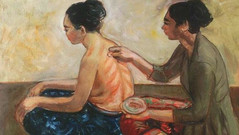 "I enjoyed reading the article on coins in medicine. The comment that silver coins worked better to elicit various sounds reminds me of a quip from a neurologist when I went to medical school 1969-1972 in UK. He said the best instrument to elicit the Babinski reflex (toes curl down when the sole is stroked) was a Bentley key. And the best instrument to elicit a knee jerk was a solid gold cigarette case!"
"I enjoyed reading the article on coins in medicine. The comment that silver coins worked better to elicit various sounds reminds me of a quip from a neurologist when I went to medical school 1969-1972 in UK. He said the best instrument to elicit the Babinski reflex (toes curl down when the sole is stroked) was a Bentley key. And the best instrument to elicit a knee jerk was a solid gold cigarette case!"
To read the earlier E-Sylum article, see:
COINS IN MEDICINE
(https://www.coinbooks.org/v25/esylum_v25n47a27.html)
HERMON MACNEIL PLASTERS MOVE COMPLETED
As mentioned a couple weeks ago, James Haas and a crew of helpers transported several plasters of Hermon Atkins MacNeil's works to a new home. It was MacNeil who modeled the Standing Liberty Quarter and other numismatic products. Here's his report on the historic trip. Thanks! -Editor
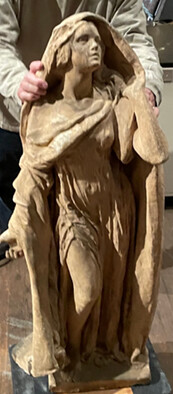 The August, 1917 issue of the The American Architect included an article titled
The August, 1917 issue of the The American Architect included an article titled Waste in Art
, The writer quoted Hermon Atkins MacNeil's recent address before the American Federation of Arts
during which he suggested the establishment of a gallery in Washington where plaster casts of the
best American work in sculpture could be permanently assembled for the purpose of study. The
Sculpture Gallery in the City Art Museum in St. Louis had collected a handsome collection by
securing sculptors' plasters that had served their purpose. While these represented works that totaled
more than a million dollars, they were acquired practically without cost.
Fast forward to October 1948 when the Corcoran Gallery of Art in Washington D.C. decided to clean up its cellar. By offering its collection of 60 plasters to the District schools, students were provided the opportunity to study great works of art. Many were scooped up.
In the spring of that year, the Sheldon Swope Gallery in Terre Haute, IN had asked for some, perhaps inspired by its recent gift of eighteen of MacNeil's plaster models donated by his widow, Cecelia Muench MacNeil. The works were put in storage where they remained for the next 75 years.
MacNeil had moved to the tiny enclave of College Point in Queens, NY in 1902, and for 30 of his 45 years there, served on the Board of the village's Poppenhusen Institute. In 2011 Daniel Neil Leininger, a MacNeil family descendant, had founded a website, https://hermonatkinsmacneil.com/ devoted to all things MacNeil. He informed Poppenhusen Institute leadership that the Swope had the plasters in storage and was willing to give selected pieces to them.
For more than a decade the cost of transport to College Point was prohibitive. Learning that the space where the plasters were stored was to be repurposed, the plasters destroyed, and MacNeil's works lost to the world, it was an easy decision for current Poppenhusen Institute Board member Charles Chiclacos and I to agree to use our own funds in order to rescue them, no mean feat. To that end we rented a U-Haul van and on November 14th , began a 1,700-mile-round-trip- odyssey from College Point to Terre Haute then back to College Point three days later.
A few, very few of the thirteen pieces were relatively light, but the statues, five in number, one of them George Washington, averaged 42 in height and weighed seemingly nearly a ton each, but in reality, weighed at least enough to be a challenge to the combined weight-lifting abilities of we two septuagenarians. Two models, Industry and Peace for the McKinley Memorial in Columbus, Ohio were smaller, but cumbersome. All had to be swaddled in layers of bubble wrap, secured by heavy duty, tightly wound plastic wrap, placed securely in the van then cushioned by bags of packing peanuts.
The plasters, all of them intact, are now once again in storage at the Poppenhusen Institute, a three-story building that was dedicated in 1868, designated a New York City landmark in 1970, and in 1973, listed on the National Register of Historic Places. The models will remain in storage until some necessary renovations are complete. Installation and dedication are in the future, but before that can take place, cleaning and conservation will have to be undertaken. The Institute already has four MacNeil works, Portland's Coming of the White Man, Chicago's Père Marquette, The Conrad Poppenhusen Medal and a work by Carol Brooks MacNeil titled War Babies. With the addition of the rescued plasters, and the donation of my research used in the writing of Hermon Atkins MacNeil: American Sculptor in the Broad, Bright Daylight, it is my hope that the Poppenhusen Institute, not quite a gallery in Washington, DC, will become the go-to place for the general public to see the largest collection of his works, and a haven for anyone wanting to do research on MacNeil.
For those who might wish to make a donation, the Poppenhusen Institute is a 501(c) (3) tax exempt organization. The address is 11404 14th Road, College Point, NY 11356. Make your check payable to "Conrad Poppenhusen Association" and mark your check: Plasters Cleaning & Conservation. Thank you.
Swope Museum's Indispensable Jim, Yours Truly, Swope Curator Amy MacLennan, and Charlie Chiclacos
A great adventure - thanks! Please do consider making a donation, everyone! This is interesting numismatic history. -Editor
Jim adds:
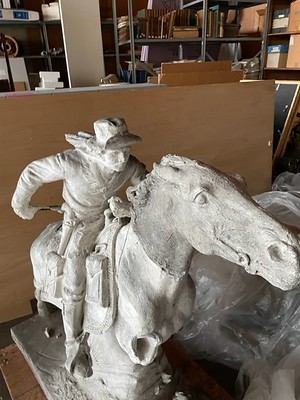 "We came upon this model just moments before departure. It was his plaster for the Pony Express figure that was destined for St. Joseph, MO. I was totally unaware it was in the Swope Museum, and was not included on the list of those we brought back to College Point. I later learned the museum had other plans for it, one of MacNeil's favorite works.
"We came upon this model just moments before departure. It was his plaster for the Pony Express figure that was destined for St. Joseph, MO. I was totally unaware it was in the Swope Museum, and was not included on the list of those we brought back to College Point. I later learned the museum had other plans for it, one of MacNeil's favorite works.
Sidebar story. Like many towns, villages and cities, the streets in College Point are presently in disarray due to the installation of much-needed new sewer pipes. As a result, the most harrowing part of the journey was driving on one of two possible streets to the Institute. One was bad, the one we chose was very bad. Charlie and I had packed the plasters as securely as we could separating them with plastic bags filled with packing peanuts. Each time we went over a bump or drove over a pot hole, they swayed forward and backward and/or side to side. Plaster is fragile; our hearts were in our throats. When we stopped to check status, winds blew peanuts out the door, given their freedom when the bags exploded. It was a hoot. All's well that ends well. Everything arrived in good shape other than what had happened to them over seventy-five years."
https://hermonatkinsmacneil.com/
To read the earlier E-Sylum article, see:
HERMON MACNEIL PLASTERS ON THE MOVE
(https://www.coinbooks.org/v25/esylum_v25n46a09.html)
RIDDELL'S NOTES ON THE NEW ORLEANS MINT
One of the highlights of the upcoming Kolbe & Fanning December 2022 numismatic literature sale is a rare edition of Riddell's Notes on the New Orleans Mint. -Editor
Extremely Rare Illustrated 1847 Second Edition of Riddell's Notes on the New Orleans Mint
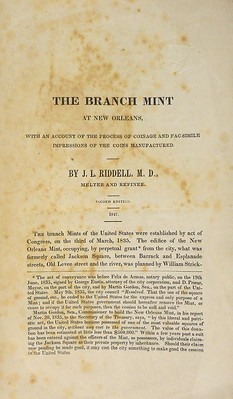 382 Riddell, J.L. THE BRANCH MINT AT NEW ORLEANS, WITH AN ACCOUNT OF THE PROCESS OF COINAGE AND FAC-SIMILE IMPRESSIONS OF THE COINS MANUFACTURED. No publisher imprint. Second edition, 1847. 8vo, original plain yellow paper covers. 10 pages; illustrations of both sides of eight coins (see comments). Foxed, particularly the blank covers; folded and somewhat wrinkled. Good. $2500
382 Riddell, J.L. THE BRANCH MINT AT NEW ORLEANS, WITH AN ACCOUNT OF THE PROCESS OF COINAGE AND FAC-SIMILE IMPRESSIONS OF THE COINS MANUFACTURED. No publisher imprint. Second edition, 1847. 8vo, original plain yellow paper covers. 10 pages; illustrations of both sides of eight coins (see comments). Foxed, particularly the blank covers; folded and somewhat wrinkled. Good. $2500
Only the second copy to have come to market of which we are aware. John Leonard Riddell (1807–1865) was Melter and Refiner at the New Orleans Mint from 1838 to 1849, and the author of A Monograph of the Silver Dollar, Good and Bad (1845), a classic work on the American dollar that remains useful to scholars today. Later in life, Riddell served as the New Orleans Postmaster during the pivotal period of secession and the outbreak of the Civil War. He also published two editions of his account of operations at the New Orleans Mint.
The first of these publications appeared in 1845, with the printing of The Mint at New Orleans with an Account of the Process of Coinage. The copy of this that appeared in the Eric P. Newman Library sale in 2018 is the only copy known to us in private hands. Part I of that edition was reprinted in the New Orleans Annual and Commercial Register of 1846, published by E.A. Michel & Co.; the only copy of that which we have handled appeared in the first David Fanning auction (subsequently renumbered Sale 113 of the Kolbe & Fanning series) as lot 238.
A second edition
appeared in 1847, with the first printing being unillustrated: that was published in De Bow's Commercial Review of the South and West (Volume III, Number 6 [July 1847]); the only copy of that printing that we have handled appeared in our Sale 155 (lot 380), where it brought $5000 hammer.
The present lot is a second printing of the second edition, referring to the De Bow's printing on page 8 and supplementing it with updated mintage information andmost importantlyillustrations of the obverse and reverse of five silver and three gold New Orleans coins. The illustrations resemble those used in the author's 1845 silver dollar monograph. There, Riddell described them as being produced by metal types adapted for printing, indirectly from the coins themselves, which, if they do not always make a handsome print, give a perfectly correct, and I think, satisfactory representation.
The resulting illustrations appear crude at first glance, but on closer examination are discovered to be remarkably accurate: much more so than if they had been printed from woodcuts or through lithography. These illustrations, together with the updated information provided within, make this printing the most significant of Riddell's publications on the New Orleans Mint.
An example of this rarity was sold in 2008 in a Bloomsbury (New York) auction; to the best of our knowledge, no other copy has been publicly offered since. Ex Maidstone Museum and Public Library, with their blind-stamp on the opening page.
To read the complete lot description, see:
Extremely Rare Illustrated 1847 Second Edition of Riddell's Notes on the New Orleans Mint
(https://bid.numislit.com/lots/view/1-6O6VW1/extremely-rare-illustrated-1847-second-edition-of-riddells-notes-on-the-new-orleans-mint)
To read the Catalogue PDF, see:
https://www.numislit.com/images/upload/kolbefanningsale165.pdf
To read the earlier E-Sylum article, see:
KOLBE & FANNING AUCTION SALE 165 ANNOUNCED
(https://www.coinbooks.org/v25/esylum_v25n46a02.html)
KOLBE & FANNING AUCTION SALE 165 HIGHLIGHTS
(https://www.coinbooks.org/v25/esylum_v25n47a04.html)
VOCABULARY TERM: MEDAL COLLECTING
Here's another entry from Dick Johnson's Encyclopedia of Coin and Medal Terminology - a wonderful discussion of medal collecting. The list of medal collections in American museums is extremely useful, although dated - it includes the Baker Collection at the Historical Society of Pennsylvania, now deaccessioned but largely recreated at the American Numismatic Association due to Dwight Manley's efforts. -Editor
Medal Collecting. Acquiring and bringing together a number of medallic specimens of some related theme, as a topic or thematic. Unlike coin collecting, which is dominated by dates and mintmarks within series, at least in the United States, medal collecting is far more dramatic. It encompasses a universe of varying designs, larger sizes, higher relief, more artistic treatment, far more topics to collect, and better condition of specimens (since, unlike coins, medals do not abrade by circulating). Once only royal families collected medals, exchanging gift medals among themselves. Today medal collecting can be enjoyed by people of all walks of life. However, it does require immense curiosity and a strong intellect for the art and history that medal collecting entails.
Medals' inherent allure. Much of the allure of medals is their mystery. Thousands of medals have been created that numismatists have never seen. They come on the market – when they do surface – often from nonnumismatic sources: from estates of recipients, in antique dealers' stock, even at flea markets and tag sales. One never knows where or when a medal, otherwise unknown, can surface.
Often they are one-of-a-kind. Coin collectors accustomed to multimillion mintages are amazed medals have such rarity. It is never evident how many medals of one kind were made; it could be one, one hundred and one, or a thousand and one (more than that quantity would undoubted have surfaced in the numismatic market). There are no mint reports from medal makers that reveal quantity struck (mintage of medals is very infrequently revealed). Thus, rarity is evident in every medal. (And medals awarded and inscribed make every recipient's medal unique!)
Medallic inscriptions are usually shortened to reveal only the briefest statement about the event or person portrayed. This also adds somewhat to the mystery. Determining the event – why the medal was issued – is often not that obvious and uncovering this reason, and related facts, is part of the thrill of medal collecting.
But the greatest thrill of all is medallic beauty. Medal designers are less constrained (than coin designers) because they have greater liberty in size, height of relief and technological requirements to create miniature works of art. Medallic beauty abounds!
Medal Collecting in Europe. Collecting medallic items began in Europe when royal families built large collections by issuing their own medals and exchanging these with other royal families. Many of these were personal medals, bearing images of family members. Others, of course, commemorated important events. A medal prior to the 17th century was, in effect, an early photograph, often a portrait, which could be cast in as many copies as necessary to fulfill family or memorial needs. Large royal collections of medals were created.
The first medals were cast – in 1438 – as were all until the screw press was devised in 1506, both events in Italy. Ever since then, medals have been made by casting, striking, hand engraving, or niello. European artists raised this field to a fine art. It was an art supported, not only by royalty, but by a growing merchant class who were the early private collectors.
National mints in Europe struck medals right from their inception, not only for national events but for private firms as well. The Paris Mint struck medals for collectors since the 17th century. The first private medal manufacturers were European and these flourished in Italy, France, Germany, and England; later in Austria, Switzerland, Spain, Sweden, Poland, Holland and Belgium.
Medal Collecting in America. Medals were issued in America even before Washington came into office. These were for the public, to be enjoyed by people in all stations of life, not like European royalty. The first medal made in America was advertised March 3, 1790 in The Pennsylvania Packet and Daily Advertiser. It bore Washington's portrait and was offered by Jacques Manly of Philadelphia (the medal has been known ever since as the Manly Medal
). The engraver was Joseph Wright (who later would become the first chief engraver when the United States Mint was formed two years later). Wright engraved the portrait from a Washington painting made in 1784.
From this early beginning, interest in Washington medals grew. But, surprisingly, most were struck back in England at what was to become the first private mint
– the Soho Mint in Birmingham of Matthew Boulton. He and his associate, James Watt, improved on existing coining presses, the process of making blanks, and the engraving of dies. However, since none of the English die engravers had a picture or likeness of Washington, their depictions of George took on a variety of illusions. He looked like a Roman emperor on one, a uniformed military general on another, a country bumpkin on another, or, on one, even their own ruler George III!
The popularity of George Washington and the many medallic memorials issued in his honor attracted the public's attention to American medals. This continued, somewhat, for later presidents, particularly Andrew Jackson, and for medals issued for presidential political campaigns.
The medals issued before America became a nation were struck in Europe. These American colonial medals were gathered and cataloged by an American numismatist more than a century after our founding. We call these medals by their cataloger, Betts medals, after C. Wyllys Betts. Having been struck and collected in Europe, it was more than a century before these were collected in America.
Just prior to the Civil War, however, Washington medals were so popular that the United States Mint at Philadelphia issued them in several sizes, including a dime size, called cabinet medals. These were struck in bronze, silver and gold and mated with other presidents on the reverse. Buyers placed them in watch crystal cases and made pendants of them.
In 1859 the top mint official, Superintendent James Ross Snowden, created a Washington medal exhibit at the Mint, wrote a book on the subject, and even struck a medal for the occasion – the Washington Cabinet Medal, 1859. This event was unique in American history: a mint official who became a medal collector, a numismatist, an author and medal issuer!
Despite a flurry of Washington medals issued on the centennial of his taking office in 1889, the collecting of Washington medals began waning in the 1870s. Prices of prized specimens dropped dramatically, and it wasn't until the mid 20th century that it again attracted sufficient collector's attention (and prices regained, and even surpassed, 19th century values).
Medals issued for political campaigns, mentioned earlier, grew as the nation grew. A small cottage industry of engraving and diesinking shops sprung up to make token-size medals. Their small presses, however, limited the size they could strike but poured forth medals that candidates could distribute (much like celluloid buttons invented two generations later). Presidential campaigns spurred hundreds of varieties. These same firms also created the thousands of varieties of cent-size tokens caused by the coin shortage near the time of the Civil War.
But the largest impetus for collecting medals, however, occurred at the Columbian Exposition in Chicago in 1892-3. Over 600 medals were issued for this occasion, both in foreign countries and in America. In fact, this one event gave rise to the beginning of medal industry in America (see medal manufacturing). These pieces ranged from crude (from makers who had never made medals before), to very elaborate and exquisite pieces from the most talented medalists. Later expositions included medal issuing as well, but not on the scale of the Columbian Exposition.
In 1909 occurred a reason for collectable medals to be issued – the centennial of the birth of Lincoln – and many were. A collector of these, Robert Hewitt Jr., built a large collection, issued two medals, and, as an innovation, bound these two medals in books on Lincoln. His collection was donated to the Smithsonian.
It wasn't until the 1960s when an explosion in medal collecting occurred with the popularity of proof surface medals. Thousands were issued to supply a market among the public that had been hyped on silver medals as an investment, not necessarily for their art or historical interest.
Simultaneously with the public interest in proof medals came along the American Bicentennial. Medals were issued by everyone imaginable! The nation. States. Cities, Counties. Historical societies. Fraternal organizations. July 4, 1976 was a magical date.
But the medal boom did not last long past this date, and most of the silver medals were melted in the great silver meltdown of 1980 when the price of silver soared ten times normal. Medal manufacturing companies sprung up to cater to this demand, just as quickly disappeared.
How medals are collected. Washington medals, campaign medals, exposition medals, or even bicentennial medals, are topics themes by which medals are acquired and systematically arranged. They are not collected like coins (by date and mint), but by their subject matter. Since literally millions of medals have been made (usually in the most advanced industrial nations), it is impossible to collect them all. In many instances, as with award medals, there may only be one or two issued.
Collectors pick their own topic. They carve out a group, from the many millions of past medals, and choose their own individual collecting specialty. While they define their personal topic, there are, perhaps, 250 or more, popular medal collecting topics. These include: sports (and Olympics, of course), expositions, naval and ships, art, aviation, space, architecture and buildings, animals, religion, music, Masonic, medical - and dozens of other professions – and hundreds of geographical areas (particularly the country their ancestors came from, or the state where they were born or currently reside). These topics for medal collecting are included in a code (which includes tokens as well) called mat code.
If a new collector hasn't defined what his topic is, he can collect Americana (just about every medal produced in or about America) until he hones in on a more manageable topic. No one can tell a medal collector what to collect, he must choose his personal topic himself.
Usually a collector will collect several topics at any one time, dropping one (and selling off these specimens), to maybe start another, all the while he develops one that becomes a first love, a topic of life-long attraction. This becomes a desire to add to at every occasion, for, unlike coins, a medal collection, it seems, can never be complete.
Medal collectors. There are perhaps 3,000 medal collectors in America, however, no more than 600 to 800 are actively buying at any one time (at end of 20th century). Some coin collectors buy medals for the closeness of medals to coins. Some art collectors buy medals, particularly those created by prominent sculptors. (Collectors of paintings have turned to collecting smaller objects, like medallic art, when their walls are full and they have no more room, for medals are easy to display or store.) Some historians buy medals for the association of a medal to a historical field or subject of their interest. But, always, the dedicated medal collector acquires specimens to be included in his chosen topic.
There have been some prominent medal collectors in America. Philanthropist John Pierpont Morgan was an active collector. ...
It must be noted that medal recipients are different from medal collectors. Prominent inventors, for example, receive many awards. The Edison and Wright brothers estates each have a large medal collection, yet none were medal collectors. These were strictly award medals.
Medal collections in American museums. It seems every local museum has medals in its collections. And perhaps this is proper, it is serving a local area, it should have medals of local interest. There are, however, some quite large medal collections in public museums. Adjacent is a brief list of American museums with medals in their holdings (major collections noted).
- Smithsonian Institution, Washington, DC – very large; contains some intact collections: National collection, King Collection of Lincoln, Kress Collection of Renaissance (in National Gallery of Art), Lilly Collection, others; many duplicates.
- American Numismatic Society, NY City – extensive; Eitlitz Collection of Architecture, medals of their own issue.
- American Numismatic Association, Colorado Springs, Colo. – large; from many donated sources.
- Metropolitan Museum of Art, NY City – American, European, high artistic content.
- New-York Historical Society, NY City – Extensive, U.S. Obviously many New York City medals.
- Museum of the City of New York, NY – New York City medals.
- Jewish Museum, NY City – Extensive Jewish medals, Samuel Friedenberg Collection medals and plaques.
- Newark Museum, Newark, NJ – large, includes Frank Liveright Collection, Whitehead & Hoag (a producer of medals in the city, donated by Whitehead family).
- Yale Collection, New Haven, Conn. – large, as department within the library. Johns Hopkins University Evergreen House Foundation, Baltimore, MD – Medical medals.
- College of Physicians of Philadelphia, PA – Medical medals.
- University of Illinois Classical and European Culture Museum, Urbana, IL – Classical medals.
- R.W. Norton Art Gallery, Shreveport, LA – Modern medals.
- Bowdoin College Museum of Art, Brunswick, ME – Large Malloinili Collection of Renaissance medals.
- Walters Art Gallery, Baltimore, MD – Art medals, plaques.
- U.S. Naval Academy Museum, Annapolis, MD – Naval medals, Malcolm Storer Naval Collection.
- United States Military Academy, West Point Museum. West Point, NY – military medals.
- United States Airforce Academy, Colorado Springs – aviation medals.
- Baker University Library, Baldwin, KS – Small, Arthur B. Coole Collection Oriental medals.
- Boston Medical Library (as part of Harvard Libraries of Medicine), Boston, MA – - Medical medals (4,000), Malcolm Storer Medical Collection.
- Delta State University Department of Art, Cleveland, MS – James A. Townes Medal Collection.
- Detroit Historical Museum, Detroit – Detroit medals.
- Missouri Historical Society, St. Louis – Lindbergh medals.
- Princeton University Library, Princeton, NJ – Small, Arthur L. Newman Collection aviation medals.
- Knights of Columbus Headquarters Museum, New Haven, CT – Columbus medals.
- Historical Soc of Pennsylvania, Philadelphia – W.S. Baker Collection of Washington medals.
- Franklin Mint Museum, Franklin Center, PA – modern medals.
- Judah L. Magnes Museum, Berkeley, CA – Jewish medals of their issue.
- Miami University, Miami, FL – Theodore Spicer-Simpson collection of medals.
- Brookgreen Gardens, Murrells Inlet, SC – medals as art objects. Herbert F. Johnson Museum of Art, Cornell University, Ithaca, NY. John E.
- Marqusee Collection of American art medals. ME. John E. Marqusee Collection of American art plaques.
To read the complete entry on the Newman Numismatic Portal, see:
Medal Collecting
(https://nnp.wustl.edu/library/dictionarydetail/516288)
EZRA HILL (1838-1860)
American Numismatic Biographies author Pete Smith submitted this article on a very early and very young numismatist named Ezra Hill. Thanks! -Editor
This week I went on a quest to construct a biography for Ezra Hill. He is noted as a founding member of the American Numismatic Society in 1858 but not traced after 1860. The quest took me to some surprising places.
On the evening of April 6, 1858, a dozen men (and boys) gathered at the home of Augustus B. Sage for the first official meeting of the American Numismatic Society. Signing in just ahead of Sage was Ezra Hill who gave his address as 248½ Bowery. This is a few blocks west of the Sage apartment at 121 Essex Street in New York City. Sage was born on May 13, 1841, and would have been short of his seventeenth birthday. Ezra Hill would have been 19 or 20.
I wonder how this group found each other. Sage probably developed his interest in numismatics around age fifteen. Hill would not have attended the meeting if he did not have an interest prior to 1858. It is possible that one connection was John K. Curtis with a shop at 83 Bleecker Street. That puts him two blocks northwest of Hill's later store at 6 Bleecker Street.
Sage wrote a recollection of Hill that was published in the American Journal of Numismatics in February 1867.
Poor Ezra Hill, long since dead and buried, a victim of consumption, commenced collecting in
1858; he never was fortunate enough to obtain any very rare pieces, but was enthusiastic, and by
his earnest nature and pleasant ways assisted materially in the good work of creating a taste for
the science. Many and many a night have I examined with him our collections, comparing the
acquisitions of the day and speculating as to how soon our collections would rival Mickley's. A short time prior to his death he obtained a small place on Bleecker Street, No. 6, and did for a
while quite a thriving business in buying and selling articles in the line of coins, autographs, etc.
The Bleecker Street store was in the NOHO district of Manhattan [NOHO is NO of SOHO] near the intersection of Bowery and Houston Streets. This is not far from his home address on Bowery. Sage created a timeline with Hill dead shortly after establishing his business on Bleecker Street in 1860 and long since dead by 1867.
I was interested in the comments about Mickley indicating that young collectors in New York were aware of the Mickley collection several years before it was sold at auction. Sage's recollections indicate he visited Mickley in Philadelphia about that time.
Ezra Hill commissioned storecards produced in 1860 with his address at 6 Bleecker Street in New York City. These were extensively muled with obverse dies that appear on tokens for other dealers of the time. Sage also commissioned several storecards in 1860.
On April 25, 1860, there was an auction conducted by Bangs and attributed to Ezra Hill as
owner. The cover text may have promised more than it delivered. Catalog of an Extensive and
valuable Cabinet of Coins, Medals and Tokens, Comprising choice Specimens of various
Countries, many of them are very scarce and particularly rich in those of America.
Most of the lots sold for less than a dollar. Total realized for the 675 lots was $332.69. The highest price I noted among the American coins was $7.50 for a 1791 Washington Cent with nothing else over $5. A couple of lots that got my attention were eight uncirculated cents of 1850 to 1857 at 2 cents each; 1792 cent, eagle on a rock [fantasy] for $2.63; Dickeson, American Numismatical Manual at $3.53.
The Census can be a great resource for biographical or genealogical research. However, the Census is plagued with errors. I was initially frustrated that I could not find Ezra Hill in the 1860 Census.
I have learned a trick that may work in a situation like this. I found him by looking for listings for his mother and sister. There is an apparent 1860 match for an Edgar Hill. Sometimes Census takers got information from a neighbor that may not have been totally accurate.
I found records for an Ezra D. Hill who may have been the ANS member. He was born in 1838 making him 20 when he joined the ANS. His mother was Sarah Fisk Hill (1814-1873) and his sister was Emma D. Hill Crogan (1839-1919) who was married to Henry A. Crogan. Sarah and Emma are buried with Henry Crogan at Lakewood Cemetery in Minneapolis. I have visited there several times visiting the gravesites of numismatists A. M. Smith, William Lanphere and Elias Rasmussen.
Ezra Hill died on December 31, 1860, at age 22, and is buried at Greenwood Cemetery in Brooklyn. I have not identified any other relative buried there.
Hill and Sage were not the only young numismatists who formed the ANS. Edward Grow was born on June 2, 1837, making him 20 at the time. There may have been other youngsters among those who made little impression during a brief membership.
Thank you - this is great information. I added the storecard image from an offering found on eBay. Pete notes that the token has the head of actor Edwin Forrest and is not a portrait of Hill. Can anyone add more about Ezra Hill? -Editor
To read the complete lot description, see:
(1860) E HILL NY-316wm COIN DEALER NEW YORK CITY MERCHANT TOKEN
(https://www.ebay.com/itm/354324563088)
A PHOTOGRAPH OF JULES FONROBERT
Julia Casey submitted these research notes and a newly discovered photo of collector Jules Fonrobert. Thanks! -Editor
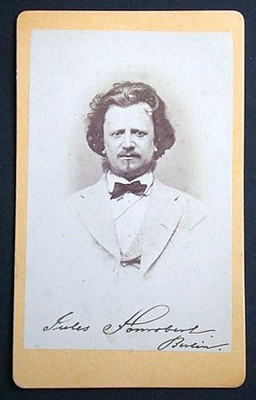 I came across this portrait photograph of Jules Fonrobert, a Berlin
I came across this portrait photograph of Jules Fonrobert, a Berlin felt factory owner.
I believe this to be the same Jules Fonrobert whose famous collection was sold by Adolph Weyl c. 1878-1879. The website (The History of Berlin
) lists a date of death of 1895, but I am inclined to think this is an error. Numismatic researchers have found an 1879 obituary for Fonrobert, and while the photograph may be of another Jules Fonrobert, I think it is the same individual as the coin collector, and the 1895 death date is mistaken.
Fonrobert's obituary was translated for The E-Sylum in 2013 by Ralf W. Böpple, with further commentary by Bob Leonard.
In addition, I found a baptismal record for Jules Fonrobert confirming a September 4, 1831, date of birth. His full name on this record is Charles Julian Francois Fonrobert. However, I have seen his name listed in different ways i.e. Charles F.J. Fonrobert, Charles Francois Jules Fonrobert, and Karl Julius Franz Fonrobert. I would be interested in any feedback from E-Sylum readers!
For more on the Fonrobert photo, see:
Francois Jules Fonrobert
(https://www.diegeschichteberlins.de/geschichteberlins/datenbanken/historische-fotografien/photo/149-fonrobert-francois-jules.html)
To read the earlier E-Sylum article, see:
THE OBITUARY OF JULES FONROBERT
(https://www.coinbooks.org/esylum_v16n01a19.html)
COUNTERFEIT TRAINING GIVEN TO LAW OFFICERS
This press release from the Anti-Counterfeiting Educational Foundation (ACEF) describes a recent seminar for law enforcement officers. Great endeavor, and nice turnout! -Editor
 The Anti-Counterfeiting Educational Foundation recently conducted an eight-hour class,
The Anti-Counterfeiting Educational Foundation recently conducted an eight-hour class, Counterfeit Coin and Precious Metals Investigations
to 35 Kansas and Missouri local, state and
federal law enforcement investigators. Participants in the ACEF seminar were shown examples of fake numismatic items during the training session held in the Kansas City suburb of Mission, Kansas.
This educational program is one of the many strategic initiatives of ACEF to address the mass proliferation of counterfeit coins and precious metals within the U.S. marketplace,
said seminar co-presenter Doug Davis, ACEF Director of Anti-Counterfeiting.
Chris Hersey, Senior Agent in the U.S. Treasury Department Office of Inspector General, and I prepared a comprehensive presentation designed to provide attendees with the skill set to thoroughly investigate counterfeit coin and precious metals cases and identify the tools and investigative resources provided by ACEF,
explained Davis, a former Texas Police Chief.
The class began with a basic overview of the numismatic and precious metals industry to familiarize attendees with the many complexities involved in numismatic and counterfeit crime investigations.
By understanding the inner workings of these types of crimes the attendees gained the knowledge to identify clandestine activities of counterfeiters and targeted victims,
said Davis.
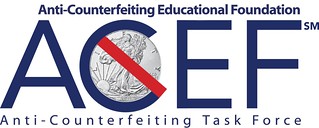
The class provided the law enforcement professionals with the fundamental investigative techniques and resources, knowledge, and understanding to respond effectively to the complex challenges encountered during the investigation of crimes related to counterfeit coinage and precious metals. Attendees received a certificate of attendance and PCGS and NGC encapsulation samples as educational tools for other investigators within their respective agency.
The continued success of ACEF depends entirely upon the support of the numismatic industry and community. ACEF is a 501(c)(3) non-profit corporation and monetary contributions can be made online at www.acefonline.org/donate or by check to ACEF, 28441 Rancho California Rd., Ste 106, Temecula, CA 92590.
For additional information about donating, contact ACEF Executive Director Brueggeman at info@acefonline.org.
THE BOOK BAZARRE
NGC INTRODUCES 10-POINT COIN GRADING SCALE
You've all probably seen this news elsewhere by now, but I wanted to include this press release and ask for some reader comments. While we generally don't discuss coin grading or pricing, major changes at the grading companies are hobby history in the making. We reported earlier on ownership changes and the ascent of sports card traders, with John Feigenbaum noting "that rare coins are clearly taking a back seat to sports cards." -Editor
A path to growth for coin collecting, the new 10-point grading scale will supplement the 70-point Sheldon scale, which will continue to be used by NGC.
Numismatic Guaranty Company¢ (NGC®) is excited to introduce NGCX, the first 10-point grading scale for coins. The 10-point grading scale has long been the standard for most collectibles, including comic books, sports cards, trading cards and more. Now, with NGCX, coin collecting will benefit from the same intuitive and approachable scale.
A timeless hobby meets the 10-point grading scale
For centuries, coins have been collected for enjoyment, for study, as an investment and as a benchmark of achievement. In the late 1940s, a numeric scale of 1 to 70 was introduced by Dr. William Sheldon to describe the relative values of US one cent coins. In theory, a coin graded 1 would be worth $1 and a coin graded 70 would be worth $70. The values quickly became irrelevant, but the grading scale stuck. NGC adopted the Sheldon grading scale when it was established in 1987, and it remains the industry standard to this day.
Meanwhile, the collecting instinct has expanded to include comic books, sports cards, trading cards, video games and much more the list continues to grow as new categories emerge, with collectors seeking to protect and preserve the things they love. These collectibles are virtually always evaluated on 10-point grading scales, which new collectors quickly recognize and readily understand. Each 10-point grading scale is precise and nuanced based on the collectible type.
NGCX, only from NGC
The 70-point grading scale for coins isn't going anywhere. Rather, NGC recognized an opportunity to bring in new collectors to the hobby by wielding the power of X NGCX a 10-point grading scale for coins.
The NGCX 10-point grading scale aligns with today's expectations for coin grading, and what it means to be the best. On the NGCX scale, 10 is the supreme grade, equivalent to a 70 on the traditional scale. The subsequent grades cascade from 10, a criterion understood by all. For example, a coin graded NGCX Mint State or Proof 10 has no imperfections at 5x magnification, the same as a coin graded NGC Mint State or Proof 70. Likewise, an NGCX Mint State or Proof 9.9 is the same as a coin graded NGC Mint State or Proof 69 each a fully struck coin with nearly imperceptible imperfections.
Be part of the revolution
NGC is the world leader in third-party coin certification because of its constant innovation and collector focus, with NGCX being only the latest example. While there is no difference in quality between a grade on the 10-point scale and a grade on the 70-point scale, the difference for the hobby is exponential. New collectors now have a clear path to embrace coin collecting. The path is NGCX.
NGCX-certified modern coins, minted from 1982 to present, will be available through select retailers beginning January 2023.
At this time, NGCX is not available for regular submissions to NGC, which will continue to be graded according the 70-point scale.
So - what do you think? Will this be remembered as a turning point in numismatic history, or just a passing marketing gimmick? -Editor
To read the complete article, see:
Introducing NGCX, a 10-point Grading Scale for Coins
(https://www.ngccoin.com/news/article/10916/introducing-ngcx/)
To read the earlier E-Sylum article, see:
PCGS PARENT COLLECTORS UNIVERSE PURCHASED
(https://www.coinbooks.org/v23/esylum_v23n49a11.html)
FEIGENBAUM: COINS ECLIPSED BY SPORTS CARDS
(https://www.coinbooks.org/v23/esylum_v23n49a12.html)
WORLD BANKNOTE AUCTIONS SALE 35
Here's the announcement for the upcoming World Banknote Auctions Sale 35. -Editor
World Banknote Auctions has now launched Live Sale 35 at www.worldbanknoteauctions.com. Live Sale 35 takes place on December 1, 2022, with live bidding that day at 1 PM Eastern / 10 AM Pacific. Please note that Sale 35 is divided in two parts, each selling on a different day. The first live session with 505 lots takes place on December 1 at 10 AM PST. The second session with 486 lots closes on December 4 at 3 PM PST (special bidding rules apply for the timed sale, please see our website for details). Our bidding platform can be accessed directly by going to bid.worldbanknoteauctions.com or through our mobile apps.
World Banknote Auctions will host sales with live internet bidding every 3 weeks. Bidding for all items starts at just $10 and there is a buyer's premium of just 15% (with a minimum of $10 per lot), 25% less than the industry average. Shipping rates are flat for most items, with shipping within the United States for just $15 and overseas shipping at $30.
Bermuda 17.2.1947 P-17s PMG Gem UNC 66 EPQ 5 Pounds (Specimen)
A fantastic specimen from Bermuda, extremely scarce and not often offered. This type, in issued form, is very seldom available in Gem Uncirculated grade, and this specimen is not much more available than that. Printer's annotations are noted in the top margin and a small SPECIMEN perforation is seen near the bottom serial number. As the serial numbers indicate just 50,000 notes for this type were printed for circulation. Fantastic originality is seen in the PMG holder, and the eye-appeal is excellent. An important offering for the Bermuda specialist.
To read the complete lot description, see:
Bermuda 17.2.1947 P-17s PMG Gem UNC 66 EPQ 5 Pounds (Specimen)
(https://bid.worldbanknoteauctions.com/lots/view/4-7XJEIB/bermuda-1721947-p-17s-pmg-gem-unc-66-epq-5-pounds-specimen)
Brunei 1989 P-20s PMG Choice UNC 64 EPQ 10,000 Ringgit (Specimen)
The 10,000 Ringgit note from Brunei is a modern rarity surely on the wish list of many collectors. Along with the Singapore $10,000 it is the note with the highest contemporary face value currently being issued, and this type is now long obsolete. It's grand format and face value make for a very appealing and popular type, but both issued notes and specimens are seldom available. Specimens are about equally as scarce as issued notes, as it appears they were never made available in quantity for collectors. The first example of this type we have handled, and it is seen here in fully original choice uncirculated condition. Fantastic opportunity for the dedicated and advanced specialist.
To read the complete lot description, see:
Brunei 1989 P-20s PMG Choice UNC 64 EPQ 10,000 Ringgit (Specimen)
(https://bid.worldbanknoteauctions.com/lots/view/4-7XJEJN/brunei-1989-p-20s-pmg-choice-unc-64-epq-10-000-ringgit-specimen)
Canada, Canadian Bank of Commerce 2.1.1935 Ch. 75-18-05 PMG Choice About UNC 58 5 Dollars
Logan - Wedd signature combination. An important rarity in the Canadian chartered series, it was originally believed that this signature combination was unissued, although Charlton states that three circulated pieces are known to exist. In addition two four-subject sheets were discovered and cut up, of which this appears to be one of those eight notes. A few other miscellaneous pieces may exist, but as a whole this is a very challenging signature combination in a very popular series. To our eye it faces up like a choice uncirculated piece, with embossing visible in the PMG holder, although the technical grade is in the About Uncirculated range. Regardless, a Canadian rarity and the first we have handled.
To read the complete lot description, see:
Canada, Canadian Bank of Commerce 2.1.1935 Ch. 75-18-05 PMG Choice About UNC 58 5 Dollars
(https://bid.worldbanknoteauctions.com/lots/view/4-7XJEK1/canada-canadian-bank-of-commerce-211935-ch-75-18-05-pmg-choice-about-unc-58-5-dollars)
China, People's Republic 1949 P-829b PMG Gem UNC 65 EPQ 50 Yuan
Gem Uncirculated notes from the first series of banknotes of the People's Republic of China are some of the most popular banknotes for advanced collectors. Due to the relative low print quality and heavy circulation of these notes original Gems are few and far between, and they are very much in demand. This particular example is as fresh and bright as the day it was printed, with fully original paper and exceptional eye-appeal. While a limited number of pieces grade finer, notes at this grade level or better are very seldom offered for sale, and this is certainly one of the nicest pieces of this type we have handled. An important opportunity for the Chinese specialist.
To read the complete lot description, see:
China, People's Republic 1949 P-829b PMG Gem UNC 65 EPQ 50 Yuan
(https://bid.worldbanknoteauctions.com/lots/view/4-7XJELZ/china-peoples-republic-1949-p-829b-pmg-gem-unc-65-epq-50-yuan)
Danish West Indies 4.4.1849 P-5 PMG About UNC 55 EPQ 50 Dalere
A fully issued rarity from the Danish West Indies (present-day US Virgin Islands). This series, which was printed on thin paper is typically seen incomplete, lacking most of the signatures and a handwritten date in order to be considered fully issued. This example, which is in fully original About Uncirculated condition has all signatures (six in total) and a handwritten date of 10 June 1850. As such, it was in fact issued into circulation in the Danish West Indies and is rare as such. This was the second highest denomination in the 1849 series that is printed in Danish on the front and English on the back. An important offering not to be underestimated, particularly at this grade level.
To read the complete lot description, see:
Danish West Indies 4.4.1849 P-5 PMG About UNC 55 EPQ 50 Dalere
(https://bid.worldbanknoteauctions.com/lots/view/4-7XJENP/danish-west-indies-441849-p-5-pmg-about-unc-55-epq-50-dalere)
East Africa 15.12.1921 P-17 PMG Choice About UNC 58 EPQ 200/- Shillings = 10 Pounds
It is not often that we can offer a note of the rarity and magnitude as the present offering. This lot does not only represent a rare opportunity to acquire a classic key note from a heavily collected area, that note also happens to be the only example in the PMG population report that has been graded EPQ (Exceptional Paper Quality). With original notes continuing to appreciate in demand and value such a status should not be underestimated. In fact, with just some minor handling accounting for the grade assigned by the grading service, we feel comfortable making the statement that this is a contender for the most desirable of the very limited number of pieces known of this type. This offering might represent one of the few opportunities to ever acquire this type, as just three are in the PMG population report and the few others known are held in advanced collections, unlikely to come to the market anytime soon.
The series of banknotes printed for British East Africa are some of the most desirable banknotes ever issued in the Commonwealth, with the series filled with rarities, yet heavily collected by specialists. First established as the East Africa Protectorate, most of the region later became the independent country of Kenya, but the notes were also valid for circulation in Tanganyika (modern-day Tanzania) and Uganda. After 1920 the notes (including the one offered in this lot) were issued by the East African Currency Board, first headquartered in Mombasa and later in Nairobi.
To read the complete lot description, see:
East Africa 15.12.1921 P-17 PMG Choice About UNC 58 EPQ 200/- Shillings = 10 Pounds
(https://bid.worldbanknoteauctions.com/lots/view/4-7XJEO5/east-africa-15121921-p-17-pmg-choice-about-unc-58-epq-200-shillings-10-pounds)
European Union / Ireland 2002 P-7t PMG Gem UNC 66 EPQ 500 Euro PMG Population in 66 EPQ: 15 (8 Finer)
This now obsolete denomination always had a single note that was considered the key for the denomination, and this is it. The Irish 500 with Duisenberg signature had a minuscule print run and most were released into circulation. Finding it in Gem Uncirculated condition is anything but easy. This is easily the nicest example of this type that we have handled. For someone collecting Euro notes by signature and country of issue or simply want a modern rarity that is very much in demand, this is it. Even more recent 500 Euro's are becoming scarce, and this variety is destined to become a classic modern rarity. PMG Population in 66 EPQ: 15 (8 Finer)
To read the complete lot description, see:
European Union / Ireland 2002 P-7t PMG Gem UNC 66 EPQ 500 Euro
(https://bid.worldbanknoteauctions.com/lots/view/4-7XJEPB/european-union-ireland-2002-p-7t-pmg-gem-unc-66-epq-500-euro)
Greece 20.6.1942 P-163 PMG Very Fine 20 500,000,000 Drachmai (Nafplion Overprint)
An extremely rare overprint for Nafplion, printed after German forces had retreated from the region in September of 1944, but before new banknotes from the Bank of Greece could be introduced into circulation. A provisional handstamp is found on the front, while the text on the back authorizes their circulation and includes the signatures of two members of the committee authorizing the issue of these pieces.
The rarity of this piece is not to be underestimated. In volume 3 of Hellas Banknotes 1822 - 2020 this denomination is called "one of the rarest Greek banknotes". Just 1,000 pieces were printed (serial numbers AP406001 to AP407000) and released into circulation, and perhaps a dozen or well-circulated pieces are known to exist. As these filled an urgent need in commerce in Nafplion and circulated for about three months, the survival of an is nothing short but a miracle. By far one of the most spectacular Greek banknotes we have offered and a rare opportunity for the Greek specialist.
To read the complete lot description, see:
Greece 20.6.1942 P-163 PMG Very Fine 20 500,000,000 Drachmai (Nafplion Overprint)
(https://bid.worldbanknoteauctions.com/lots/view/4-7XJERP/greece-2061942-p-163-pmg-very-fine-20-500-000-000-drachmai-nafplion-overprint)
Iraq 1931 (ND 1938) P-11a PMG Choice UNC 64 10 Dinars
A prefix. A wonderful example of this scarce type, with fresh, original color and exceptional eye-appeal. While a group of these have turned up in recent years and as such is one of the few Iraqi notes that is sometimes available in higher grades. However, due to heavy collector interest these are very much in demand, and most are now held in advanced collections. As such, an important opportunity for the Iraqi specialist.
To read the complete lot description, see:
Iraq 1931 (ND 1938) P-11a PMG Choice UNC 64 10 Dinars
(https://bid.worldbanknoteauctions.com/lots/view/4-7XJETP/iraq-1931-nd-1938-p-11a-pmg-choice-unc-64-10-dinars)
Reunion (Isles of France and Bourbon) ND (1795) PMG About UNC 50 5 Livres
Listed in Kolsky under Isle of France and Bourbon, but issued for the French island of Reunion. Part of an extensive series of early banknotes issued towards the end of the 18th century. This particular type is unlisted in Pick and is very scarce, with a small group of pieces known to exist. We note one example in similar grade selling recently at another auction for $4,560. An important opportunity for the French colonial specialist. PMG mentions "Edge damage; pinholes".
To read the complete lot description, see:
Reunion (Isles of France and Bourbon) ND (1795) PMG About UNC 50 5 Livres
(https://bid.worldbanknoteauctions.com/lots/view/4-7XJF13/reunion-isles-of-france-and-bourbon-nd-1795-pmg-about-unc-50-5-livres)
NUMISMATIC NUGGETS: NOVEMBER 27, 2022
Here's a selection of interesting or unusual items I came across in the marketplace this week. Tell us what you think of some of these. -Editor
A GEORGE III GOLD HALF GUINEA TOKEN, 1812, by Younge & Wilson of Sheffield, EF, 3.2g, with Royal Mint certificate (Illustrated) (Est. plus 21% premium inc. VAT)
The plain obverse reminds me of the U.S. gold rush Bechtler coinage. -Editor
To read the complete lot description, see:
A GEORGE III GOLD HALF GUINEA TOKEN, 1812, by Younge & Wilso...
(https://www.easyliveauction.com/catalogue/lot/
6d3701b99b45cbcfc01c9c013f7b2321/0af8d24542e81eb9357e7ef448a6646f/
winter-antiques-interiors-auction-lot-323/)
1817 James Monroe Indian Peace Medal. Third Size. By Moritz Furst and John Reich. Julian IP-10. Bronze. Mint State.
51 mm.
From the Stack's Bowers December 2022 Tokens & Medals Collectors Choice Online Auction. -Editor
To read the complete lot description, see:
1817 James Monroe Indian Peace Medal. Third Size. By Moritz Furst and John Reich. Julian IP-10. Bronze. Mint State.
(https://auctions.stacksbowers.com/lots/view/3-105ZD5/1817-james-monroe-indian-peace-medal-third-size-by-moritz-furst-and-john-reich-julian-ip-10-bronze-mint-state)
Gold ring with a 10 x 8 mm oval of gold-bearing white quartz, total weight is 3.69 grams (0.12 ozt), size 6-1/4. Intricate swirled engraving on the shoulders. No letter engraving anywhere on the ring. The California Gold Rush introduced this beautiful stone into the world. Recovered in 2014 from Coin Pile #23 in the port-side debris field. Found associated with 4 quartz stones (HWAC #146609) as well as other jewelry, including pieces with monogramed and blank panels and cartouches, and ring styles using California nuggets as decoration, inferred to be examples of a jeweler's business and craft.
While non-numismatic itself, this nice gold ring was recovered alongside coins from the wreck of the SS Central America. There's an amazing amount of this material up for sale in the Holabird S.S. Central America artifact sales. I suspect many of these will be bought up and resold in multiple marketplaces, hopefully retaining their provenance to the wreck.
Gold bars and piles of gold coins found with the wreck were clearly cargo, but jewelry items much more likely belonged to passengers. While some 150 people survived the sinking, over 400 perished that day. But it's usually impossible to know whether any particular jewelry item was left behind by a rescued passenger or sank to the bottom with its doomed owner.
I guess time makes the connection to death less creepy. It's not like anyone pulled gold teeth from a warm cadaver; these artifacts were simple neutral survivors, enduring 130+ years undersea awaiting their rescue and a new life. Amazing. -Editor
To read the complete lot description, see:
Gold Ring, Gold-Quartz Stone, Size 6-1/4, S.S. Central America Treasure [146648]
(https://holabirdamericana.liveauctiongroup.com/Gold-Ring-Gold-Quartz-Stone-Size-6-1-4-S-S-Central-America-Treasure-146648_i46905158)
1909 G50c Washington Alaska-Yukon-Pacific Expo NGC MS63 Token
A nice little expo souvenir. -Editor
To read the complete lot description, see:
1909 G50c Washington Alaska-Yukon-Pacific Expo NGC MS63 Token
(https://live.bidhaus.com/online-auctions/bidhaus-llc/1909-g50c-washington-alaska-yukon-pacific-expo-ngc-ms63-token-4281635)
COIN OF SPONSIAN IS GENUINE. OR IS IT?
A coin in the Hunterian museum in Glasgow, long thought to be fake, has been declared genuine, but not everyone is convinced. -Editor
A forgotten Roman emperor has been saved from obscurity as a coin long thought to be fake has finally been authenticated.
The coin, unearthed 300 years ago, depicted a leader named Sponsian who was in power during the 260s AD.
It was believed to be a forgery, as it differed from both the manufacture process and general style of Roman coins from the time.
There are no other historical records that Sponsian ever existed, but new analysis suggests the coin is indeed authentic.
The coin comes from a small hoard unearthed in Transylvania in 1713 which found their way into collections around Europe.
Some ended up at The Hunterian museum in Glasgow, where they remained hidden in wooden cabinets until now.
Researchers from University College London closely analysed the coins – three of which depicted other known Roman emperors - using a range of techniques, including light microscopy and ultra-violet imaging.
On the Sponsian coin, they discovered micro-abrasion patterns typically associated with coins that were in circulation for an extensive period of time.
The researchers also analysed earth deposits on the coin, finding evidence that after its use the coin was buried for a prolonged period before being discovered.
Together, the new evidence strongly indicate the coin is authentic, the team said.
They suggest Sponsian was an army commander in the Roman Province of Dacia during a period of military strife during the 260s AD.
Curator of Numismatics at The Hunterian, Jesper Ericsson, said: "Not only do we hope that this encourages further debate about Sponsian as a historical figure, but also the investigation of coins relating to him held in other museums across Europe."
To read the complete article, see:
Ancient Roman coin thought to be FAKE after being discovered in Transylvania over 300 years ago is almost certainly authentic - and proves the existence of 'forgotten' leader Sponsian, study claims
(https://www.dailymail.co.uk/sciencetech/article-11461067/Ancient-Roman-coin-thought-fake-authenticated-proves-existence-forgotten-leader.html)
Arthur Shippee, Len Augsburger and Leon Saryan passed along a Wall Street Journal article on the coin. Thanks. -Editor
To read the complete article (subscription required), see:
Rare Gold Coins Reveal New Roman Emperor (https://www.wsj.com/articles/gold-coins-ancient-rome-emperor-sponsian-11669229082)
Howard Berlin passed along a CNN article which quotes some doubters. -Editor
Despite the study's findings, some experts, including in the field of numismatics -- the study or collection of currency -- still believe the coin to be fake.
"Like everyone in the numismatic world, I strongly believe this coin to be a modern forgery," Jerome Mairat, curator of the Heberden Coin Room in the Ashmolean Museum in Oxford, England, told CNN.
"This whole theory -- that the coin is genuine -- is both unscientific and unfounded," he added.
Dame Mary Beard, the acclaimed scholar of Ancient Rome and professor of classics at Cambridge University, wrote in a blog post published by the Times Literary Supplement that "there is still very powerful evidence that they are fakes," going on to list a number of issues surrounding their crafting and design.
To read the complete article, see:
Puzzling debate over Roman coin authenticity could determine legacy of 'fake' emperor
(https://www.cnn.com/style/article/coin-fake-emperor-real-intl-scli-scn/index.html)
On social media Arthur Needham shared a link to the original paper, correctly noting that the article is one journalist's interpretation. Other numismatic experts are not quoted. While the coins may or may not be complete modern forgeries, they could well be contemporary imitations. Thanks also to David Sundman for passing it along. -Editor
Authenticating coins of the ˜Roman emperor' Sponsian
Abstract
The Roman emperor
Sponsian is known only from an assemblage of coins allegedly found in Transylvania (Romania) in 1713. They are very unlike regular Roman coins in style and manufacture, with various enigmatic features including bungled legends and historically mixed motifs, and have long been dismissed as poorly made forgeries. Here we present non-destructive imaging and spectroscopic results that show features indicative of authenticity. Deep micro-abrasion patterns suggest extensive circulation-wear. Superficial patches of soil minerals bound by authigenic cement and overlain by oxidation products indicate a history of prolonged burial then exhumation. These observations force a re-evaluation of Sponsian as a historical personage. Combining evidence from the coins with the historical record, we suggest he was most likely an army commander in the isolated Roman Province of Dacia during the military crisis of the 260s CE, and that his crudely manufactured coins supported a functioning monetary economy that persisted locally for an appreciable period.
To read the complete article, see:
Authenticating coins of the ˜Roman emperor' Sponsian
(https://journals.plos.org/plosone/article?id=10.1371%2Fjournal.pone.0274285)
Robert Hoge writes:
"This is a rather unsatisfactory article. I hope we shall see something more substantive in the near future. The coin still looks suspicious to me. Definitely it has affinity to "Barbarian" issues."
David Sundman, David Pickup and Kavan Ratnatunga passed along a BBC News article. Thanks also to Bill Rosenblum who passed along a Fox News version. -Editor
To read the complete article, see:
Gold coin proves 'fake' Roman emperor was real
(https://www.bbc.com/news/science-environment-63636641)
David Pickup and David Sundman passed along a link from the Hunterian. Thanks, everyone. -Editor
To read the complete article, see:
SPONSIAN: THE REDISCOVERY OF A LOST ROMAN EMPEROR
(https://www.gla.ac.uk/hunterian/visit/exhibitions/changingdisplays/sponsian/)
MEDIEVAL COIN HOARD FOUND IN SCOTLAND
A hoard of medieval Scottish, English, Irish and other silver coinage has been found in Scotland. -Editor
Thousands of coins dating back to the 13th and 14th centuries were discovered by metal detectorists buried near Dunscore.
A spokesperson for the Treasure Trove Unit – which is responsible for logging new archaeological finds and preserving them for the public good – said it is one of the largest medieval coin hoards found in Scotland since the 19th century.
The discovery contains a mixture of Scottish, English, Irish and continental silver. The majority of the 8,407 coins are Edward I and II pennies and are believed to be worth hundreds of thousands of pounds.
An archaeology expert said: This is an absolutely amazing find.
After the initial discovery, the site was excavated by Treasure Trove Unit officials along with National Museums Scotland archaeologists.
Now each coin is being catalogued. This requires identifying, photographing, measuring and weighing each one.
Colin Mitchell of Dunscore Heritage Centre said he is delighted
the hoard has been found in the area and that he would welcome
the opportunity to display some of it in the village.
To read the complete article, see:
Scotland's largest medieval coin hoard in 200 years found by metal detectorists
(https://www.dailyrecord.co.uk/news/scottish-news/thousands-coins-dating-back-13th-28550481)
Thanks also to Leon Saryan, who passed along the following. -Editor
To read the complete article, see:
Amateur Metal Detectorists in Scotland Have Unearthed a Stash of 8,400 Medieval Coins, One of the Largest Finds in Scottish History
(https://news.artnet.com/art-world/dunscore-hoard-scotland-metal-detectorists-treasure-trove-unit-2214267)
CELTIC TREASURE COINS STOLEN IN GERMANY
Arthur Shippee passed along this story of a Celtic coin heist in Germany. -Editor
Thieves who broke into a southern German museum and stole hundreds of ancient gold coins got in and out in nine minutes without raising the alarm, officials said Wednesday, in a further sign that the heist was the work of organized criminals.
Police have launched an international hunt for the thieves and their loot, consisting of 483 Celtic coins and a lump of unworked gold that were discovered during an archeological dig near the present-day town of Manching in 1999.
Guido Limmer, the deputy head of Bavaria's State Criminal Police Office, described how at 1:17 a.m. (0017 GMT) on Tuesday cables were cut at a telecoms hub about one kilometer (less than a mile) from the Celtic and Roman Museum in Manching, knocking out communications networks in the region.
Security systems at the museum recorded that a door was pried open at 1:26 a.m. and then how the thieves left again at 1:35 a.m., Limmer said. It was in those nine minutes that the culprits must have smashed open a display cabinet and scooped out the treasure.
Limmer said there were parallels
between the heist in Manching and the theft of priceless jewels in Dresden and a large gold coin in Berlin in recent years. Both have been blamed on a Berlin-based crime family.
Bavaria's minister of science and arts, Markus Blume, said evidence pointed to the work of professionals.
It's clear that you don't simply march into a museum and take this treasure with you,
he told public broadcaster BR.
It's highly secured and as such there's a suspicion that we're rather dealing with a case of organized crime.
Officials acknowledged, however, that there was no guard at the museum overnight.
An alarm system was deemed to provide sufficient security, said Rupert Gebhard, who heads the Bavarian State Archaeological Collection in Munich.
The bowl-shaped coins, dating back to about 100 B.C., were made from Bohemian river gold and show how the Celtic settlement at Manching had links across Europe, he said.
Gebhard estimated the value of the treasure at about 1.6 million euros ($1.65 million).
The archaeologists hope that the coins remain in their original state and reappear again at some point,
he said, adding that they are well documented and would be hard to sell.
The worst option, the melting down, would mean a total loss for us,
he said, noting that the material value of the gold itself would only run to about 250,000 euros at current market prices.
Gebhard said the size of the trove suggested it might have been the war chest of a tribal chief.
It was found inside a sack buried beneath building foundations, and was the biggest such discovery made during regular archaeological excavations in Germany in the 20th century.
To read the complete articles, see:
Gone in 9 minutes: How Celtic gold heist unfolded in Germany
(https://apnews.com/article/travel-europe-germany-e6bb0cdbd6f161fb3212c0fb1171a34a)
Over 2,000-Year-Old Celtic Coins Worth Millions Stolen from German Museum in Under Ten Minutes
(https://www.artnews.com/art-news/news/celtic-coins-stolen-manching-museum-1234647794/)
Greg Cohen of Legend Auctions, Dick Hanscom of Alaska Rare Coins, Andy Singer, Gil Parsons and Bill Rosenblum passed along articles as well. Thanks, everyone. -Editor
To read the complete article, see:
Gone in 9 minutes: How Celtic gold heist unfolded in Germany
(https://news.yahoo.com/official-organized-crime-likely-behind-114656861.html)
˜Several Million' Dollars in Ancient Gold Coins Were Just Stolen From a German Museum
(https://www.msn.com/en-us/news/world/several-million-dollars-in-ancient-gold-coins-were-just-stolen-from-a-german-museum/ar-AA14tKbm)
AUSTRALIAN VICTORIA CROSS AWARDS SOUGHT
Last week we discussed a movement in Canada calling for the country to award Victoria Cross medals. While many had been awarded in WWII, none had been awarded since the selection process moved from the British monarchy to the Canadian government. It turns out Australia has a similar problem. Here's an article from The Spectator Australia - a number of WWII heroes are being promoted for Australia's VC. -Editor
Imagine today if every approval for an Australian gallantry award had to be ticked off by someone in London. That was the case in World War II. That was what our Navy had to endure. The other two forces had their awards approved in Australia. Navies take a long time to grow, and ours had been ˜parented' by the RN. When war arrived, there was no time for revision. Fighting for its life against Germany and Italy, and later Japan, Britain was understandably under extreme pressure.
Perhaps due to that, there are at least four WWII naval personnel who could have received a VC. Some received what was called a ˜Mention in Despatches', not a medal, rather a badge, albeit a prestigious one. Many thousands of Aussies were awarded a MID before it was phased out in 1975. But some of the bravest Navy personnel received no recognition whatsoever.
Ship's cook Francis Emms fought at his machine gun against Japanese aircraft until wounded, later dying aboard HMAS Kara Kara in Darwin Harbour on 19 February 1942. He received only a Mention; the VC being the only other possible posthumous possibility.
Only weeks later, Captain ˜Hec' Waller commanded HMAS Perth in battle until it was sunk, losing his life in the process. Fighting alongside the Australian cruiser, also sunk, was USS Houston. Her Captain Rooks received the very highest American award, the Medal of Honor. In fact, no one noticed Waller had not been recommended for anything at all, except post-war when – ironically – someone from the RN in Britain noticed the anomaly. The paperwork was hurriedly filled in, only for Waller to receive a MID when a VC would have been appropriate.
And at the end of 1942 – a terrible year for our Navy – Teddy Sheean manned his 20mm anti-aircraft gun even as the corvette Armidale sank underneath him, having disregarded the order to abandon ship in an effort to save his shipmates' lives.
At least these three were given a MID, with Sheean's now removed and replaced by the VC. Others received nothing.
To read the complete article, see:
Australian notes
(https://www.spectator.com.au/2022/11/australian-notes-325/)
To read the earlier E-Sylum article, see:
THE RAREST VICTORIA CROSS
(https://www.coinbooks.org/v25/esylum_v25n47a25.html)
WINNIPEG 'IF DAY' PROPAGANDA NOTES
The Bank of Canada Museum blog has a nice article about "The Day Winnipeg Was Invaded." Not really, but cool story. -Editor
Winnipeg is famous for its cold winter weather. But on the morning of February 19, 1942, Winnipeggers were not concerned about how cold it was at Portage and Main. They woke up to the wailing of air-raid sirens and a total blackout. Winnipeg was being invaded! About 3,800 German-uniformed soldiers had taken over the city.
But Germany never invaded Canada. The extent of the military threat in Canada during the Second World War was the sighting of German U-boats in the St. Lawrence River. No German soldier ever set foot on Canadian soil as part of an invading force. Yet, on that day, Winnipeggers would have begged to differ.
It was a scary scene of German occupation. Wehrmacht tanks patrolled the streets, and the Luftwaffe controlled the skies. In true blitzkrieg fashion, invasion and occupation were swift. Within a few hours, the city of Winnipeg surrendered and was renamed Himmlerstadt
(Himmler City). The invaders took over local radio stations and newspapers to control information. Propaganda slogans of everything is kaput
dominated the headlines. Checkpoints were set up to control movement in the city. People on the street were randomly stopped and searched. Some were arrested and imprisoned in an internment camp set up in Lower Fort Garry. Even German marks replaced Canadian dollars in circulationin the form of so-called If Day propaganda notes.
Media coverage of the event was widespread, with major Canadian and US newspapers and newsreel companies filing stories. Many readers and viewers thought it was real. But as news continued to unfold, they learned that the event was a mock invasion. The 3,800 invaders were Canadians dressed in German uniforms, all part of an elaborate scheme to demonstrate what a German invasion could look like. Government officials at all levels were aware of the plot. The National War Finance Committee, which was responsible for financing the Canadian war effort, orchestrated the mock invasion through its Winnipeg chapter. It was all to promote the sale of Victory Loan bonds.
Bonds to raise money for the war effort were initially issued in Canada during the First World War. The goal of the Dominion of Canada's government was to raise $50 million for the war effort. Canadians rose to the challenge and oversubscribed to the tune of $100 million. The excess funds were loaned to the British government to purchase supplies such as munitions and food.
The success of thisand later bond offeringsprompted the government to make bond drives a regular feature of its initiative to raise funds in the Second World War. In encouraging the sale of Victory Loan bonds, the occupation of Winnipeg was a daring, yet very effective stunt.
Although Winnipeg was never actually occupied, Winnipeggers spent a day experiencing what many Europeans had been going through every day since the outbreak of the war. The success of the If Day mock invasion was so remarkable that other North American cities conducted their own bond drives to raise funds for the war. The If Day notes even found their way to Vancouver, British Columbia, to promote the sale of Victory bonds there. The extreme measure taken by the National War Finance Committee?to simulate an invasion to scare people into buying Victory Loan bondswas rather audacious. But it certainly drove the message home to all Canadians that they should support the war effort in any way possible.
Found via News & Notes from the Society of Paper Money Collectors (Volume VIII, Number 23, November 22, 2022). -Editor
To read the complete article, see:
The If Day propaganda notes of the Second World War
(https://www.bankofcanadamuseum.ca/2022/11/the-day-winnipeg-was-invaded/)
NIGERIANS UNIMPRESSED WITH NEW BANKNOTES
There's a kerfuffle in Nigeria over newly introduced banknotes. -Editor
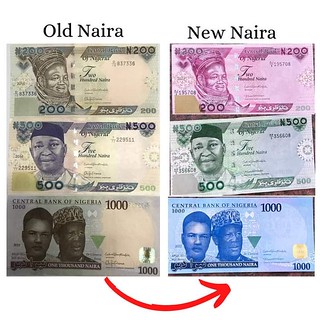 Nigerians have criticized the
Nigerians have criticized the redesigning
of the country's local currency proposed by its central bank to rein in counterfeiting and hoarding of large sums outside the banking system.
President Muhammadu Buhari unveiled the redesigned 200-, 500-, and 1,000-naira notes on Wednesday, saying the new Naira banknotes have been fortified with security features that make
them difficult to counterfeit.
The new notes look very similar to those currently in circulation. The design of the highest-value 1,000-naira note, which includes the national coat-of-arms and the headquarters of the Central Bank of Nigeria, is largely unchanged. The only significant difference is the color it's gone from a largely brown underprint to blue.
The Central Bank of Nigeria (CBN) says that the redesigned notes will replace notes currently in circulation by Jan. 2023.
But many locals are not impressed, describing the supposedly redesigned banknotes as a mere color revamp, given their similarities to the old notes.
Snapchat filter, waste of time and resources, so a whole CBN cannot employ experts to redesign the naira notes. This is a revamp not a redesign,
one Nigerian tweeted.
The value of the Nigerian naira has been in a decline in recent years, falling to a record low on the black market where it traded at nearly 800 to the US dollar as of Friday.
Old naira notes will be completely phased away by the end of January next year, the CBN says, as locals scramble to deposit their old notes at commercial banks.
To read the complete article, see:
˜It changes nothing.' Nigerians unimpressed with redesigned banknotes
(https://www.cnn.com/2022/11/25/business/nigeria-launches-new-banknotes-lgs-intl)
MAN PAYS LAWYER WITH ANCIENT COIN
A man in Natchitoches, Louisiana paid his lawyer with a Hadrian Denarius. Here's an article from the Natchitoches Times. -Editor
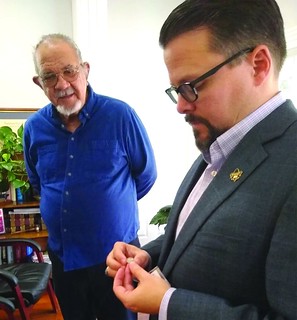 When Natchitoches resident Joe Darby needed a legal document revised recently, he agreed to pay attorney Eddie Harrington with a form of currency that doesn't see much circulation these
days: a coin dating to the Roman Empire.
When Natchitoches resident Joe Darby needed a legal document revised recently, he agreed to pay attorney Eddie Harrington with a form of currency that doesn't see much circulation these
days: a coin dating to the Roman Empire. In effect, I am paying for legal services with a 1,900 year-old coin,
says Darby. It's a silver denarius.
Darby is a history enthusiast, as is
Harrington, so their meetings typically delve into topics in history. Every time we meet for business, we end up talking history 80% of the time and business 20% of the time,
says Darby.
We exchange history books and things like that, so we've got that common interest.
Darby is also a numismatist, a collector of coins, so when he stopped in to ask Harrington about updating the legal document, their conversation drifted to a coin Darby had added to his
collection. I showed him my latest acquisition, which was a coin minted in the reign of Caesar Augustus, the first Roman Emperor,
he says. (He's) not to be confused with Julius
Caesar; that was his uncle.
Harrington's interest was piqued by the historic coin, so when the time came to discuss payment, the two struck a deal to exchange a similar coin for Harrington's services. How much is your
fee Eddie? Oh, a silver denarius,
Darby muses about their previous meeting. Darby focuses on collecting French, British and American coins and didn't have another silver denarius to spare,
so Harrington suggested an alternative Roman coin.
He marvels at the coins features. Most coins, especially this old that I've seen, the detail has been rubbed off, because it's been used so many times, but you can see his eyes and everything.
The detail is amazing.
He flips the coin over to see the reverse, which bears a woman's figure along with a Latin inscription.
He puzzles over the text's meaning for a moment before Darby offers an insight. That's all one word, providentia, so that female figure's probably Providence,
Darby suggests. I understand that in the second century, the denarius was worth about a day's wage for a skilled laborer,
like a craftsman: a carpenter or a mason.
The Hadrian coin is only the second Roman denarius Darby has ever acquired, so he takes a moment to compare its quality to that of his collection. I'm working on collecting medieval
French monarchs right now,
he says. This is a lot better made than the medieval coins from England and France. They were very, very thin, almost wafer-like (and) they were cruder.
The art of minting coins deteriorated after the fall of the Roman Empire.
Darby takes a last look at the Hadrian Denarius.
To read the complete article, see:
Numismatist returns ancient silver to circulation
(https://www.natchitochestimes.com/2022/11/22/numismatist-returns-ancient-silver-to-circulation/)
LOOSE CHANGE: NOVEMBER 27, 2022
Here are some additional items in the media this week that may be of interest. -Editor
CoinsWeekly published a short bio of Texas radio pioneer Gordon McLendon, a collector of ancient Greek and Roman coins. It was originally published in a Numismatica Ars Classica catalog. -Editor
To read the complete article, see:
Gordon McLendon (1921-1986)
(https://coinsweekly.com/whoswho-sammler/mclendon-gordon-1921-1986/)
Pablo Hoffman passed along this Delanceyplace book excerpt on Salmon P. Chase and the invention of national banks. Thanks. -Editor
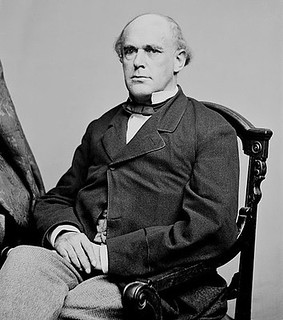 At the time of the Civil War, the country had only state-chartered banks, and these were the issuers of more than 8,000 different types of currency (typically issued as proceeds of loans) in the economy. There had been no national currency in the country, other than the brand-new 'greenbacks' first issued by the Treasury in 1861 as an expedient to help finance the war -- and which were expected to be removed from the system after the war (which did not happen until 1878). But Treasury Secretary Salmon Chase had a revolutionary idea to bring the system under more national control and at the same time help finance the war: The country would authorize the creation of national banks, which would be required to buy Treasury securities in an amount equal to a portion of their capital. State bank currency would soon come to be taxed, which effectively put them out of the currency-issuing business. Suddenly, banking in America had become a creature of the federal government:
At the time of the Civil War, the country had only state-chartered banks, and these were the issuers of more than 8,000 different types of currency (typically issued as proceeds of loans) in the economy. There had been no national currency in the country, other than the brand-new 'greenbacks' first issued by the Treasury in 1861 as an expedient to help finance the war -- and which were expected to be removed from the system after the war (which did not happen until 1878). But Treasury Secretary Salmon Chase had a revolutionary idea to bring the system under more national control and at the same time help finance the war: The country would authorize the creation of national banks, which would be required to buy Treasury securities in an amount equal to a portion of their capital. State bank currency would soon come to be taxed, which effectively put them out of the currency-issuing business. Suddenly, banking in America had become a creature of the federal government:
"While Lincoln praised legal tender (his first public comment on the greenback), he nonetheless looked to a return to a gold basis at the earliest possible moment, presumably after the war. Paper money had proved a brilliant expedient, but it was still an expedient. Some more permanent currency was needed. Yet Lincoln, like Chase, knew there was no going back to the old mix of gold and silver coins plus Treasury and assorted state bank notes. With the postwar world coming into view, the President recommended Chase's long delayed banking reform. Indeed, Lincoln said, 'I know of none which promises so certain results [of] a safe and uniform currency.'
To read the complete article, see:
THE INVENTION OF NATIONAL BANKS -- 11/14/22
(https://www.delanceyplace.com/view-archives.php?4719)
Greg Cohen passed along this New York Times article about the return of a stolen document to Mexico. Thanks. -Editor
 For roughly 30 years, a 16th-century purchase order signed by the conquistador Hernán Cortés, who led the overthrow of the Aztec empire for the Spanish crown, had been missing from Mexico’s national archives and, instead, had made its way to private auction blocks across the United States.
For roughly 30 years, a 16th-century purchase order signed by the conquistador Hernán Cortés, who led the overthrow of the Aztec empire for the Spanish crown, had been missing from Mexico’s national archives and, instead, had made its way to private auction blocks across the United States.
The document from 1527 was stolen from the Archivo General de la Nación de Mexico in Mexico City sometime before 1993, according to a court filing by the U.S. attorney for Massachusetts.
The document belonged to the Fondo Hospital de Jesús at the Mexican archives. According to the Mexican authorities, the collection was declared national property and was cataloged in 1929. A manuscript that remains in the collection has a record showing that 12 pesos were used to buy pink sugar
for the navy's pharmacy in connection with an expedition.
According to an F.B.I. investigation, the manuscript was purchased at an auction in the 1990s by the founder of the Museum of World Treasures in Wichita, Kan. His family consigned the document to Goldberg Coins and Collectibles in Los Angeles, and in 2019, a Florida resident purchased it at auction. That person then contracted with RR Auction in Massachusetts, where the document was put up for auction in June.
To read the complete article, see:
(https://www.nytimes.com/2022/11/23/us/cortes-manuscript-mexico-boston.html)
THANKSGIVING AND THE U.S. MINT
Readers may not realize it, but there's a connection between Thanksgiving and the U.S. Mint. -Editor
Everyone knows the story of the first Thanksgiving – in November 1621, the newly-arrived Pilgrims convened with the Wampanoag natives to celebrate an autumnal harvest celebration, later dubbed Thanksgiving. But how did Thanksgiving transform into the national tradition we know and love today?
After the inaugural celebration of Thanksgiving, there were a handful of other similar celebrations that took place. However, it wasn't until the late 18th century that Thanksgiving was officially proposed as a national holiday. Elias Boudinot (1740-1821), a resident of Elizabeth, NJ, was a prominent Statesman and member of the 1st U.S. Congress. Throughout his political career, Boudinot would go on to serve as the Director of the United States Mint. Aside from his career in public service, Boudinot was also a celebrated lawyer who practiced out of Newark.
On September 25th, 1789, Boudinot issued a proposal suggesting that Congress should encourage George Washington to establish a holiday for a day of public thanksgiving
. The resolution hoped to inspire gratitude among the American people. As the Constitution had just been signed and America was officially independent, the fledgling country had much to celebrate and to be thankful for.
As with most things, there was some opposition to the bill, especially from southern colonies who felt the establishment of the holiday was a northern imposition. However, George Washington loved the idea and would go on to recommend it in 1789, stating Whereas it is the duty of all Nations to acknowledge the providence of Almighty God, to obey his will, to be grateful for his benefits, and humbly to implore his protection and favor, and whereas both Houses of Congress have by their joint Committee requested me
˜to recommend to the People of the United States a day of public thanksgiving and prayer to be observed by acknowledging with grateful hearts the many signal favors of Almighty God especially by affording them an opportunity peaceably to establish a form of government for their safety and happiness.'
Although Washington made the recommendation, it was not implemented as an official decree. It would be New Jersey's first Governor, William Livingston (1723-1790), who enthusiastically stepped up to make the first declaration marking Thanksgiving a holiday. For many years, Thanksgiving was mostly celebrated as a northeastern holiday. There seemed to be a particular aversion from the south, with Thomas Jefferson even stating that the imposition of Thanksgiving was a monarchical practice
. However, as time passed, the rest of the country would eventually come around, officially establishing Thanksgiving as a national holiday.
To read the complete article, see:
THIS WEEK IN HISTORY: EXPLORING THANKSGIVING'S GARDEN STATE ROOTS
(https://www.trentondaily.com/this-week-in-history-exploring-thanksgivings-garden-state-roots/)
FEATURED WEBSITE: HERMON A. MACNEIL
This week's Featured Web Site is about sculptor Hermon Atkins MacNeil.
WELCOME TO THE HERMON A. MACNEIL
VIRTUAL GALLERY & MUSEUM !
This Gallery celebrates Hermon Atkins MacNeil, of the Beaux Arts School American classic sculptor of Native images and American history. ~ World's Fairs, statues, monuments, coins, and more ~ Hot-links lead to works by Hermon A. MacNeil. ~ Over 200 of stories & 2,000 photos form this virtual MacNeil Gallery stretching east to west New York to New Mexico ~ Oregon to S. Carolina. ~ 2021 marks the 155th Anniversary of Hermon MacNeil's birth. ~~Do you WALK or DRIVE by MacNeil sculptures DAILY! ~~ CHECK it OUT!




